Dedo de Deus, the view from the road where we started
WE WALKED OUT OF THE RAINY MUDDY FOREST ONTO THE RAINY HIGHWAY at about 7:30 at night. It was dark except for the car headlights that would come in pulses. We had been in the rain for the last 5 hours or so, with a break of about an hour. There was nothing dry and we were used to being wet. It wasn’t cold at least, not in the fall of Teresopolis Brazil. One of our guides, Lucio, said that this was probably the last "chuvao" or big rain of the season. Lucio was a very a positive person.
On some of our adventures, the journey makes everything worth it. On others, it’s the destination. In this case, it was the survival, the walking out of the forest.
Our destination was Dedo de Deus, which means Finger of God, a 1700 m (5550 ft) slab of granite that is very prominent in the Serra das Orgaos above Rio de Janeiro. My wife grew up looking at it, never dreaming that she wanted to climb it until about three years ago when we started learning how to rock climb. When we were looking for an adventure on this trip to Brazil for her dad’s 80th birthday, she saw indications that there was an easy way up Dedo de Deus. She contacted a local guide named Gilson and he suggested that the hardest part was the hour long hike before the climbing began. "The climb is the easy part," he said. So we signed up.
Dedo de Deus, the view from the road where we started
The journey began from that same highway at an elevation of about 870 m (2850 ft). The simple math meant about 830 m (2700 ft) of elevation gain. The sun was coming up at about 6:20 am, the skies were perfect, and the temperature was about 75 degrees. We could tell it was going to be humid, though.
The first step into the Mata Atlantica – the name of the forest surrounding Dedo de Deus – was a big step up. The next hour, in fact, was basically a series of giant steps with no more than about 5 consecutive paces that would ever be considered flat. Maybe 10 minutes into it, I put my left foot on a root and it slipped, spraining the big toe, something that would hurt the rest of the day. The sun occasionally peaked through the forest, but it was thick, making it difficult to see much of anything beyond the trees and the trail. Only at one point during the trail could we look out very far and see the giant slab of sloping granite off to the left. We would be going much higher than that.
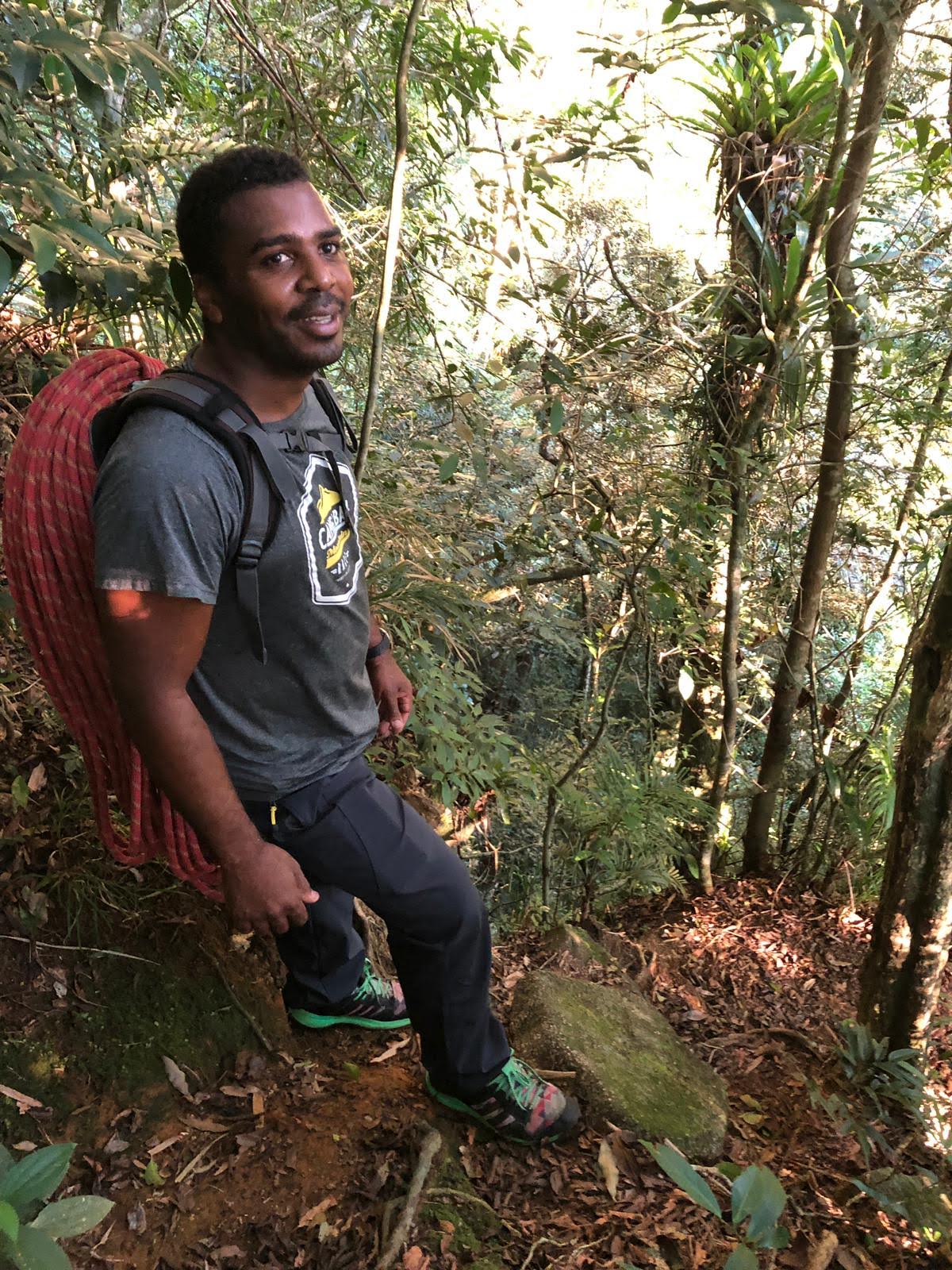
Lucio hiking up the trail. Gilson with the rope around his backpack.
The gentle sloping slab to our left that peeked out through the forest at times. Supposedly a hike/climb that is a bit easier.
We were about an hour in when we arrived at the point where the hiking turned into hiking with cables and ropes anchored on the ground. It would not be total climbing, but there were several of the same elements. We put on our climbing gear – shoes, harnesses, and helmets – and Lucio stashed his hiking gear in the forest.
At this point, the forest opened up and we could actually see Dedo de Deus again. It looked very different from this angle.
The base where we put on our climbing gear and the view of Dedo de Deus from there.
Gilson led the first pitch, called a "cordada" in Portuguese. The pitches generally weren’t full lengths of rope because of the constant winding around trees and rocks that we had to do. It was a total of about 20 pitches, which would considered insane if they were full pitches. We got the insanity of it anyway.
Marcia starting on the first pitch
On that first pitch, there was a slant off to the right that wasn’t too bad, but towards the end of it was a fairly large patch with a film of water covering it, making it very slippery. I intentionally tried to see how it was to climb, moving my feet around to try to get to the dry spot, but there was little to get traction on and I slid down about 6 ft. That would be the last time during the entire day that I would do anything but take the easiest way I could find. I was already coming to realize how preserving energy during this humid day and on this very long hike was going to be necessary.
The first section where I tried something different, but found the wet slippery rock.
Several of the pitches through here were easier than this, not going up as much as going on highly eroded trails that could crumble underneath you, which is why they had ropes or cables to hold on to. Even if you slipped, you couldn’t fall too far in the thick forest. The main management for me was hydration through the humidity. Getting leg or foot cramps would probably mean the end for me, so I was drinking an electrolyte solution that I often used for biking. It always worked reasonably well. I could get to the point where cramps felt imminent, but they didn’t come on in full force. I didn’t even feel them coming on at this point.
At about 9:45, we reached a flat area where we would snack and drink and talk and look around before the real climbing began. It was and still is truly hard to imagine the route that we took from the perspective of the ground. The way we wound around to the north is not clear. What route we actually ascended is not clear. Where this flat area was located is not clear. I’ve made an attempt to identify the location of our lunch, but I’m honestly not sure. Climbing through the forest so much without a lot of clear viewpoints made it difficult to know where we were.
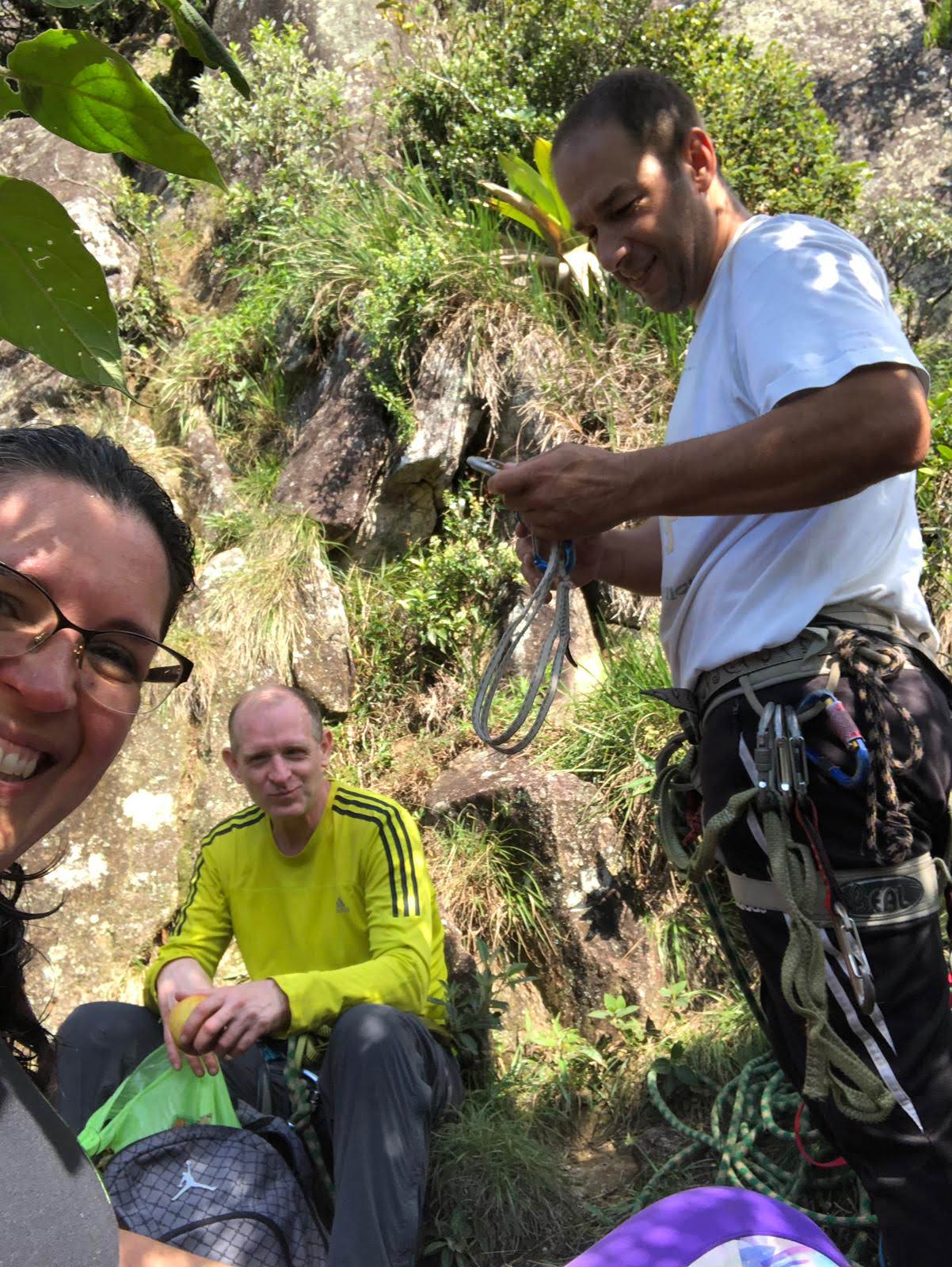
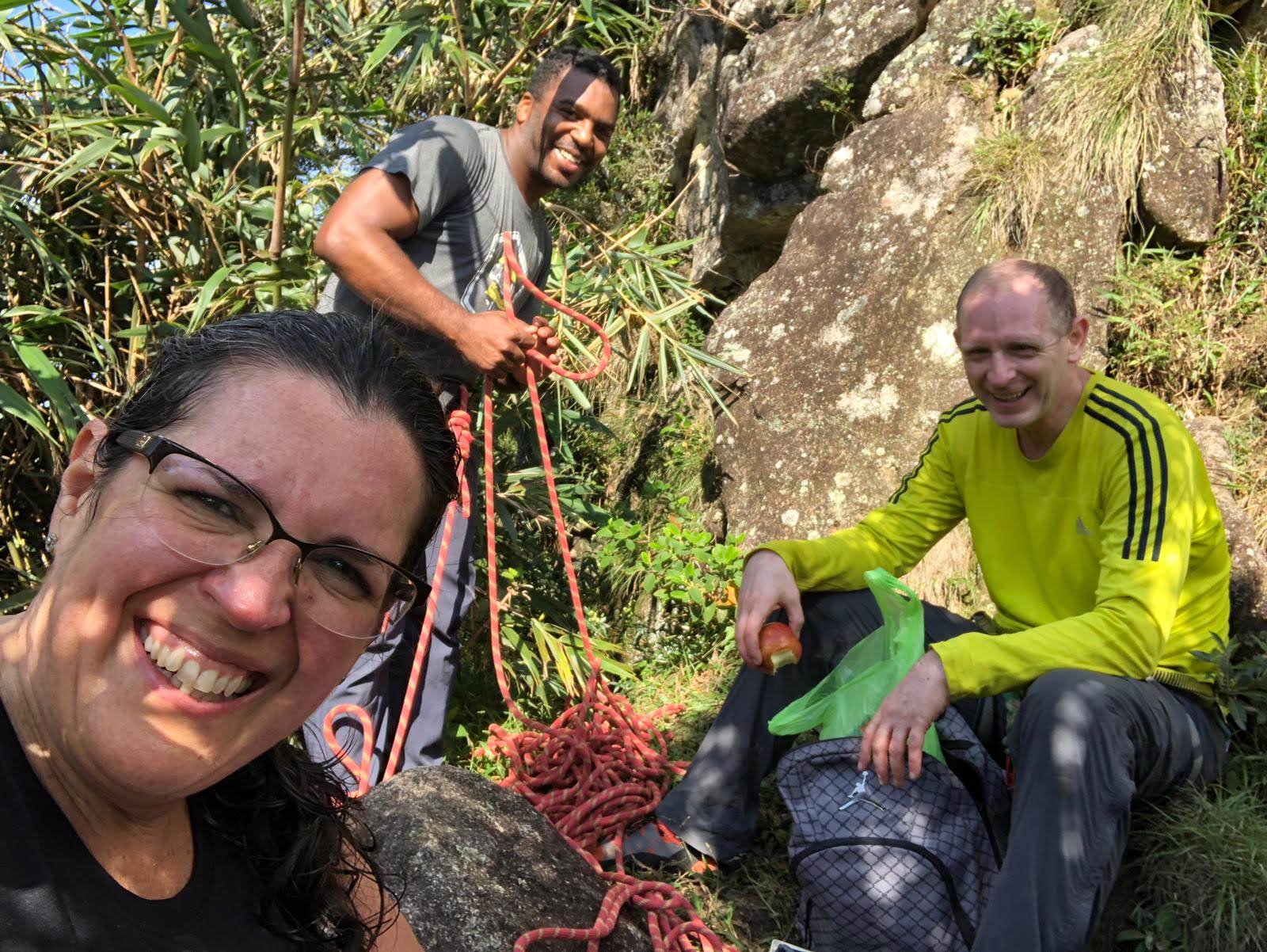
The last serious break, where we got snacks. We were already quite a ways up with a huge drop off to either side.
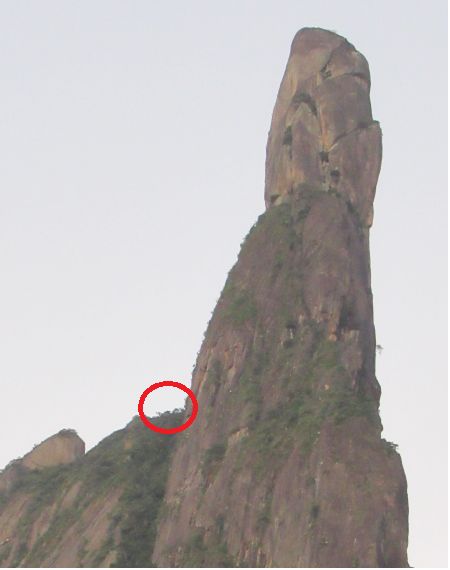
Approximate snack location and the view of Dedo de Deus from there.
The climbing began in a long crack with occasional trees sticking out. I was the last to start up and the last to arrive at a location where the other three were waiting and eyeing the next pitch. You did have to climb out of the crack a little bit to move up to the tree where people were lodged. As I moved out a little to my right to do so, I could see the long way down from where we were. Without ropes, falls here would be 1000 ft and not end well.
Sitting on that tree as Gilson and Marcia started heading up, Lucio pointed out the flower that was growing alongside the tree. It was an unusual one that grows in tropical places but at high altitude. That’s where we were and you can somewhat see the big drop below it.
The tropical flower that grows only at altitude in the tropics.
The next pitch was around a rock, going out onto a slab of granite with nothing to stop a huge descent – except the rope, of course, and I had to remind myself of that. Stay calm, cool, and collected. I have yet to learn to trust my footing when there are no small holds, just the friction of the shoes on rock – as was the situation here. So I stayed off the granite and in another crack that was probably harder for people who trusted their shoes, but it was easier for me as it had clearer holds where I could pull myself up.
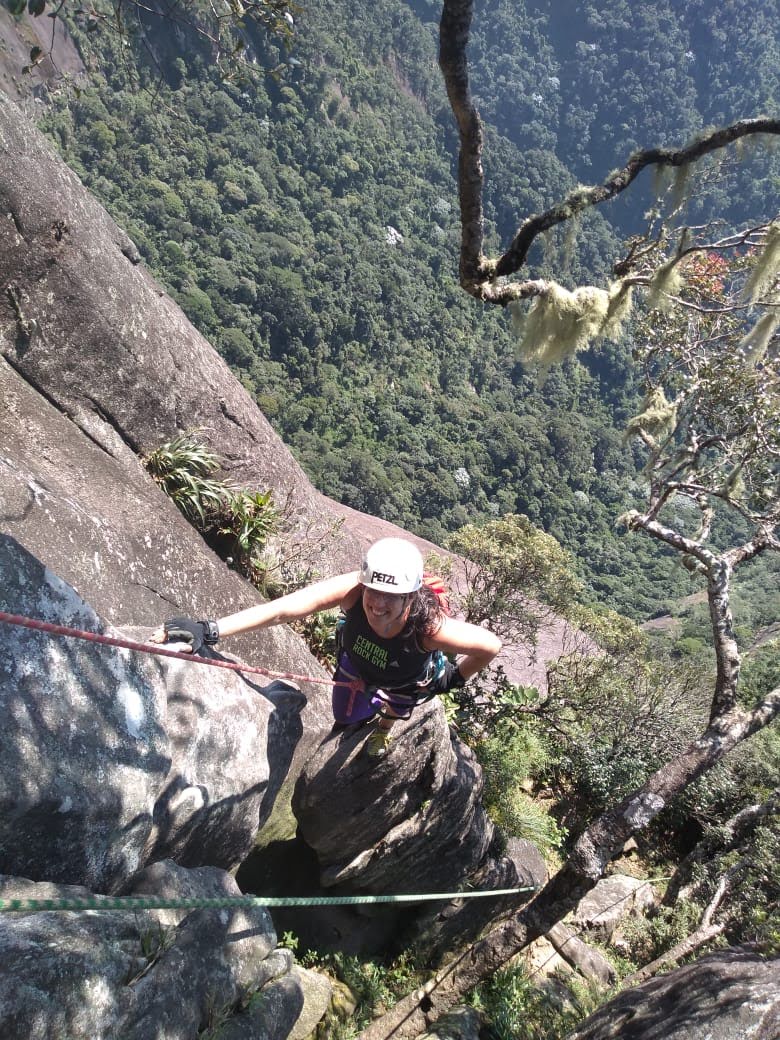
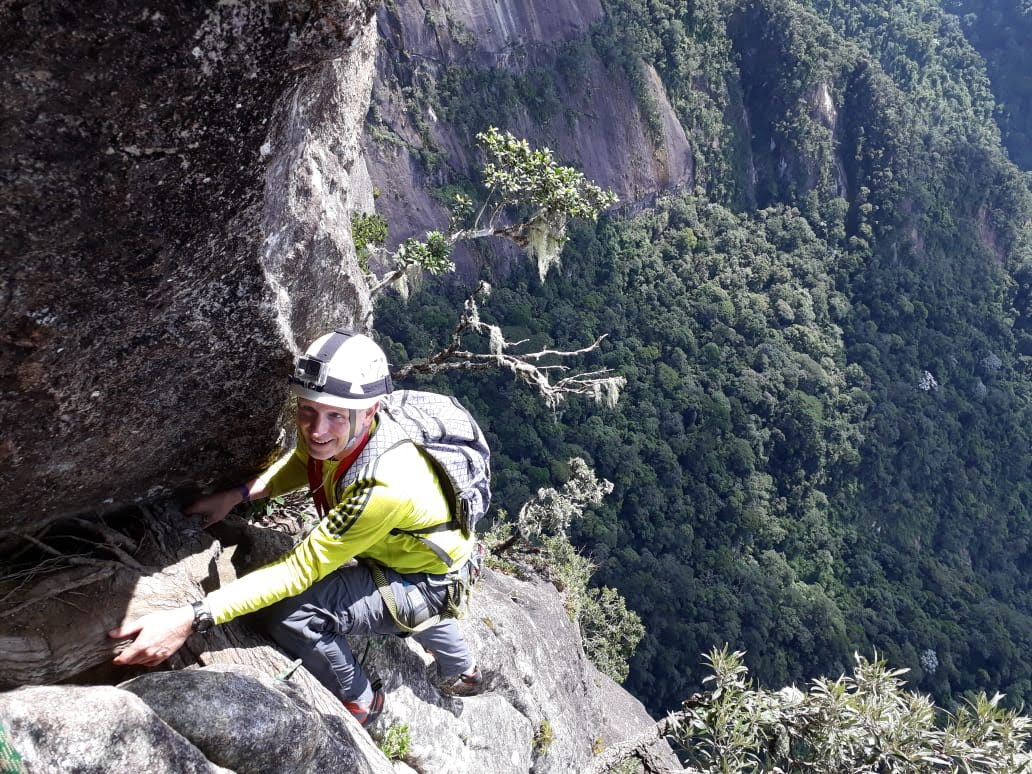
Climbing up some of the "early" pitches with no more cables and with plenty of distance below.
The combination of climbing something extremely different and listening to Portuguese was a major test. Fortunately, I passed the climbing part of the test, but I felt deficient in my Portuguese many times. Focusing on what I needed to do to get through challenging parts, ignoring the fear that comes when looking down 1000 ft and knowing that life depends on on a 10 mm rope, as well as trying to stay hydrated to avoid cramps – those didn’t make my Portuguese very good. It was also much easier to curse in English when things went bad.
Then things started to change. We were all together at an area where my wife asked whether I wanted to climb outside on a route called Maria Cebola or inside on a chimney called Black Out, basically in caves through the rock. I said inside to avoid some of the sun that was draining my energy and my electrolytes, whereas she definitely wanted to go outside. So we split up here briefly. She and Gilson started toward the outside by climbing onto a dead tree, horizontal and reaching out of the crack we were sitting in. As Marcia edged her way along the tree, she could see down a good thousand feet towards the highway where we started. She said that this is why we could call her crazy. She had to stretch across from that tree to the rock face, grabbing at whatever holds she could find. She gradually did so and as she moved past points of security, she cleared some of the gear left behind, unclipping the carabiners and straps and hooking them to her harness. She disappeared around the edge and Lucio and I started our trek on the inside of what is called a chimney.
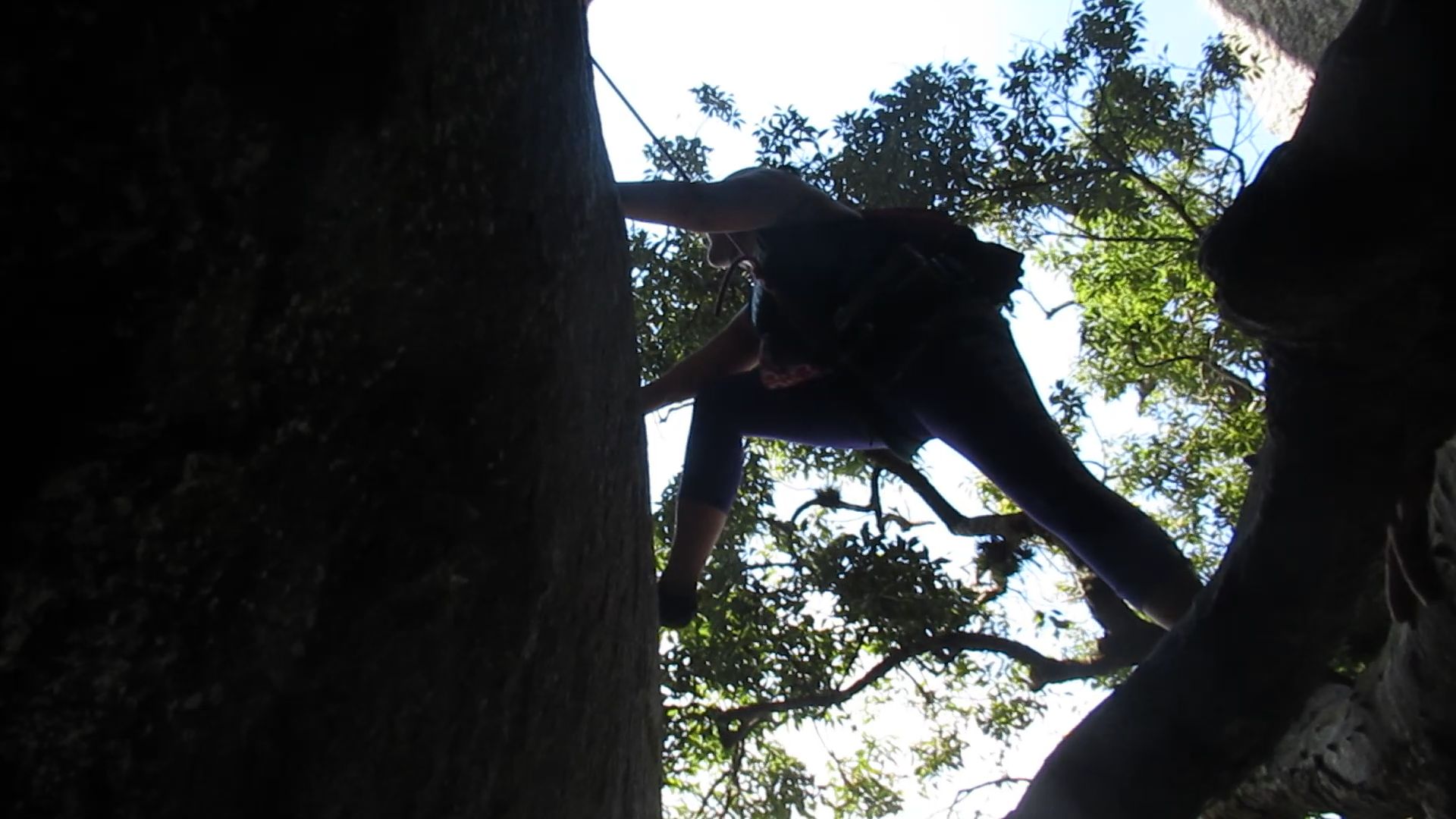
Where Marcia climbed on a dead tree to start on the Maria Cebola section, with the view of what was below her.
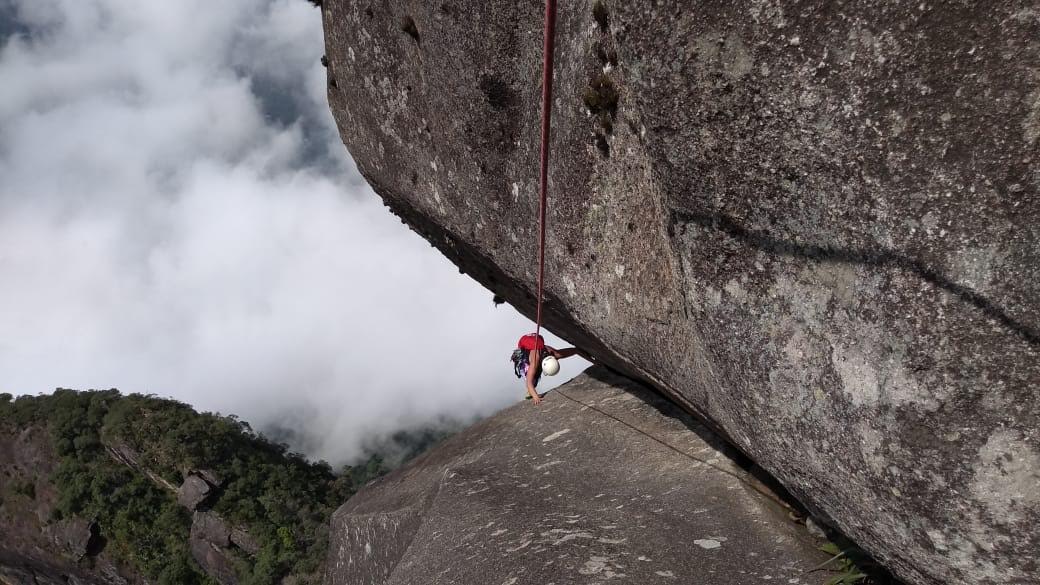
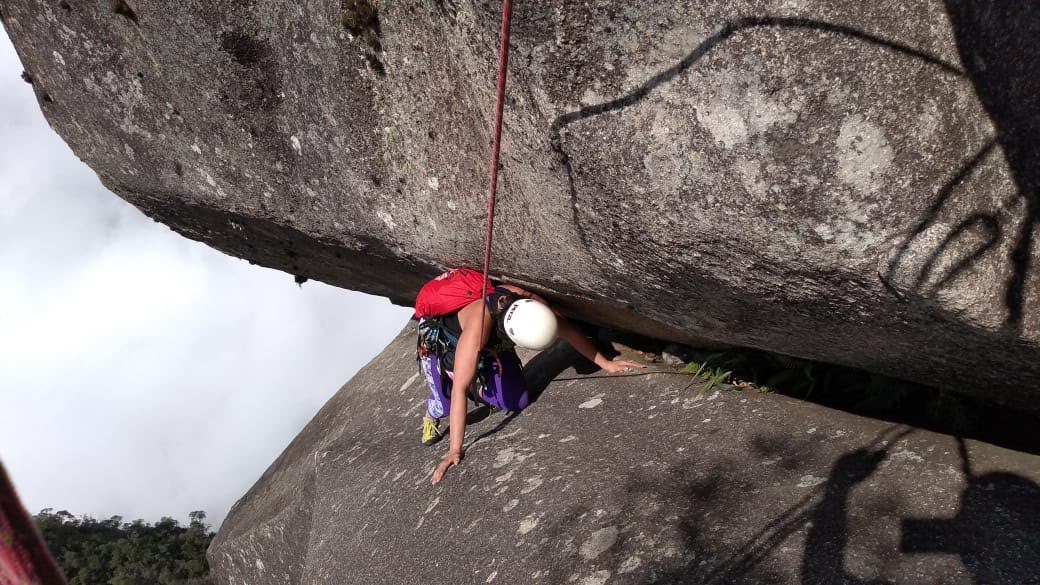
Marcia on the classic Maria Cebola section.
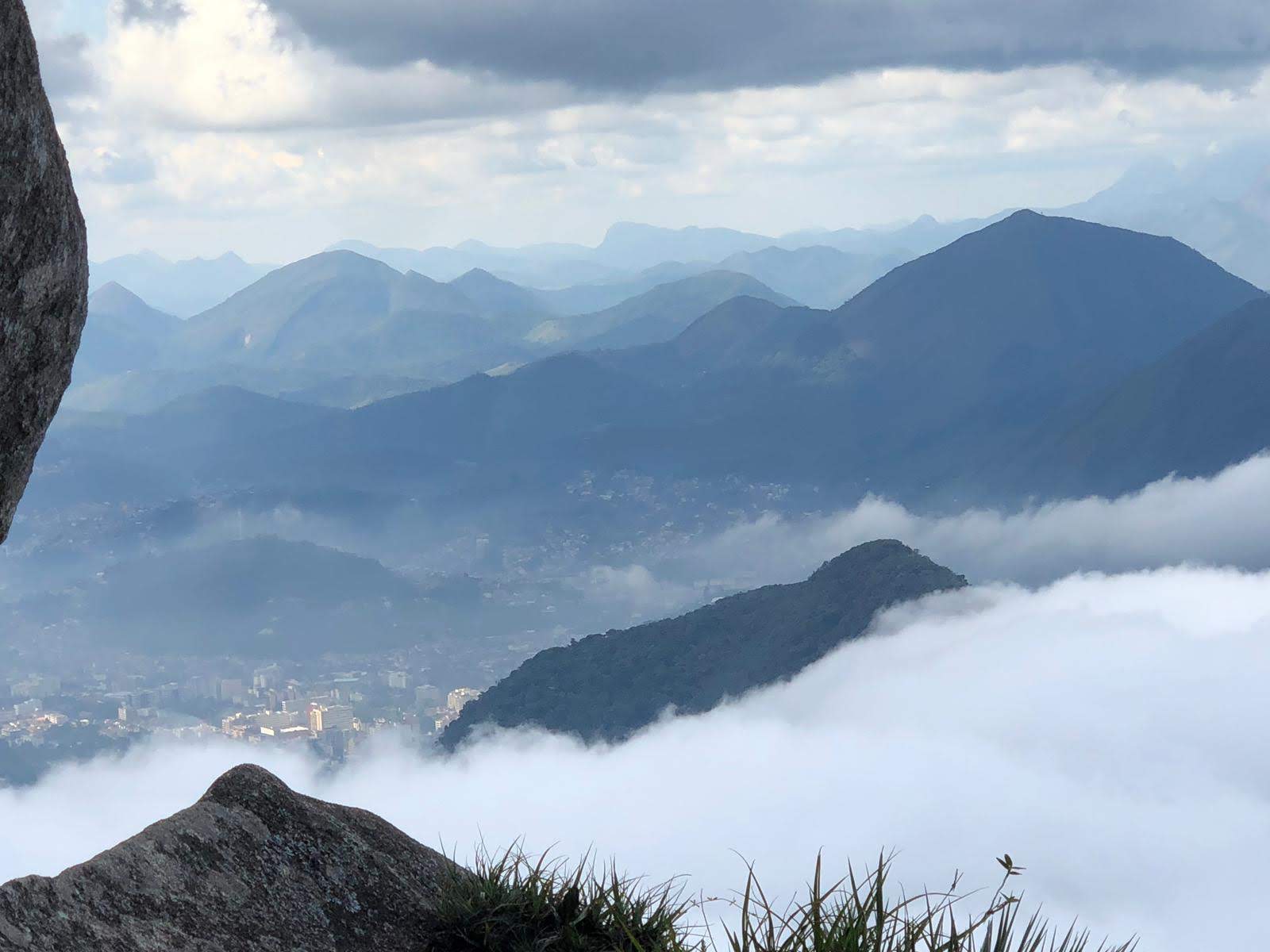
Clouds really coming in as we got to this section.
A chimney is the inside of the rock and we would do a lot of climbing in chimneys on our way up to the top. Dedo de Deus has a lot of these fractures where there really isn’t enough space to turn your body. Once you pick a position, you are in that position for a while as you use the friction of the walls around to move up or sideways. Lucio led the way on the first part, which was probably at a 30 degree angle and very narrow. The rope that he led with came all the way back to me, but he asked that I tie in the backpacks to send up to him before I go. With a loop in the rope, I attached the bags via a carabiner and sent them up. At last, I followed, my shoulders having essentially no clearance and my head having maybe a couple inches of clearance. It lasted only about 10 ft before it opened up vertically, where we were in a cave. At the end of the cave, there was something more resembling a crazy S-shaped chimney that we would have to go up vertically. It wasn’t very long, but it was extremely tight. My legs and torso were essentially up against walls as I reached up with my arms. I got to where I had to turn into the top part of the S and got my upper body through, but my waist felt stuck. I was definitely thinking that I need to lose 30 lbs at that point. I managed to wriggle through and pull myself up around the top part of the S into a more stable slot where the chimney was now about a 60 degree angle with about 18” of clearance. I slid along through there to where we met up with Marcia and Gilson again.
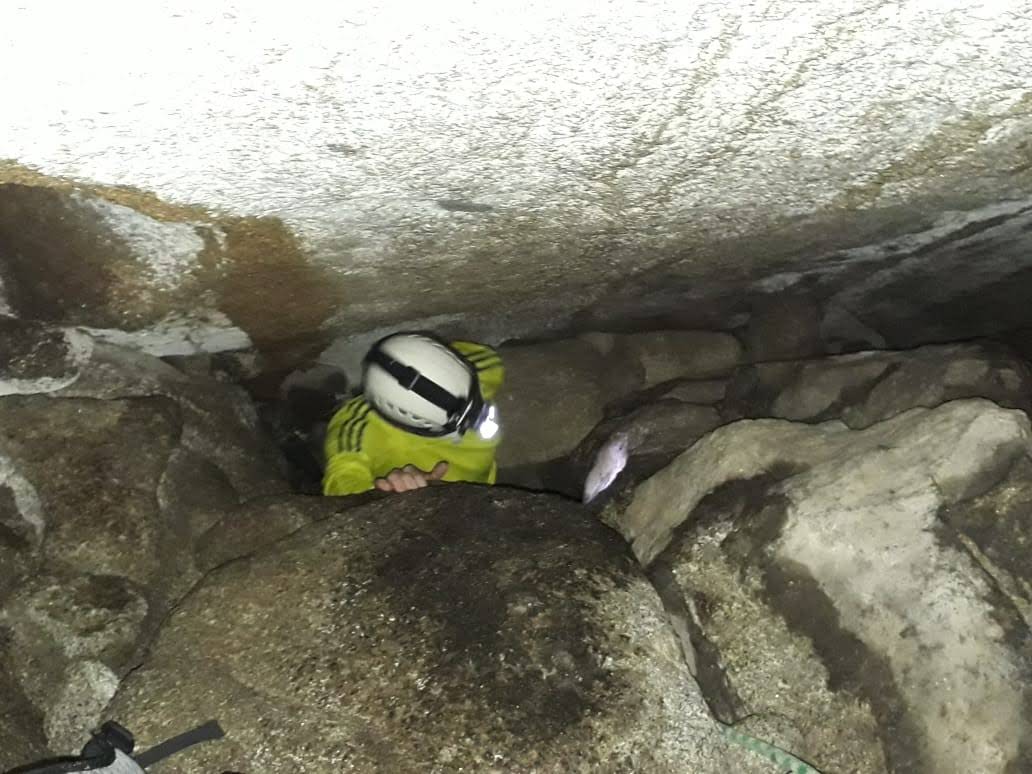
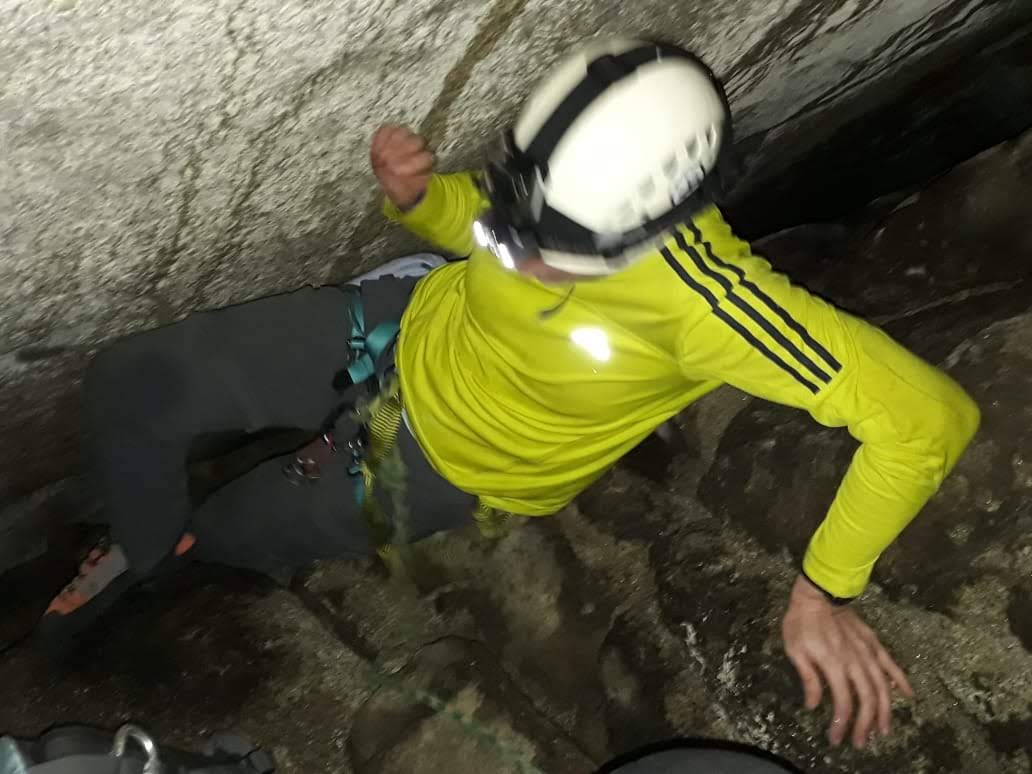
Going up the wet walls of the Black Out chimney
Here the initial climb through the chimney wasn’t bad. Marcia was cursing at it at first, but she found her way up ahead of me and Lucio. I was again last to go and couldn’t see much of what was beyond the first ten feet in front of me. That first ten feet wasn’t bad at all. Good foot holds, good friction, at an angle of about 70 degrees. Then it went vertical and I couldn’t get traction with my shoes, so I had to use all my effort with my arms to push and pull the last four feet before we could rest. This definitely concerned everyone. For them, this part was easy. For me, not having the ability to get traction on rock – smearing – has always been the hardest part for me. I’ve seen so many people climb this kind of thing easily when I just slip and slide, having to then find a small hold for my fingers to pull my entire body weight up. One of these days, I need to try either different shoes or figure out what is exactly the technique for making shoes stick to rock.
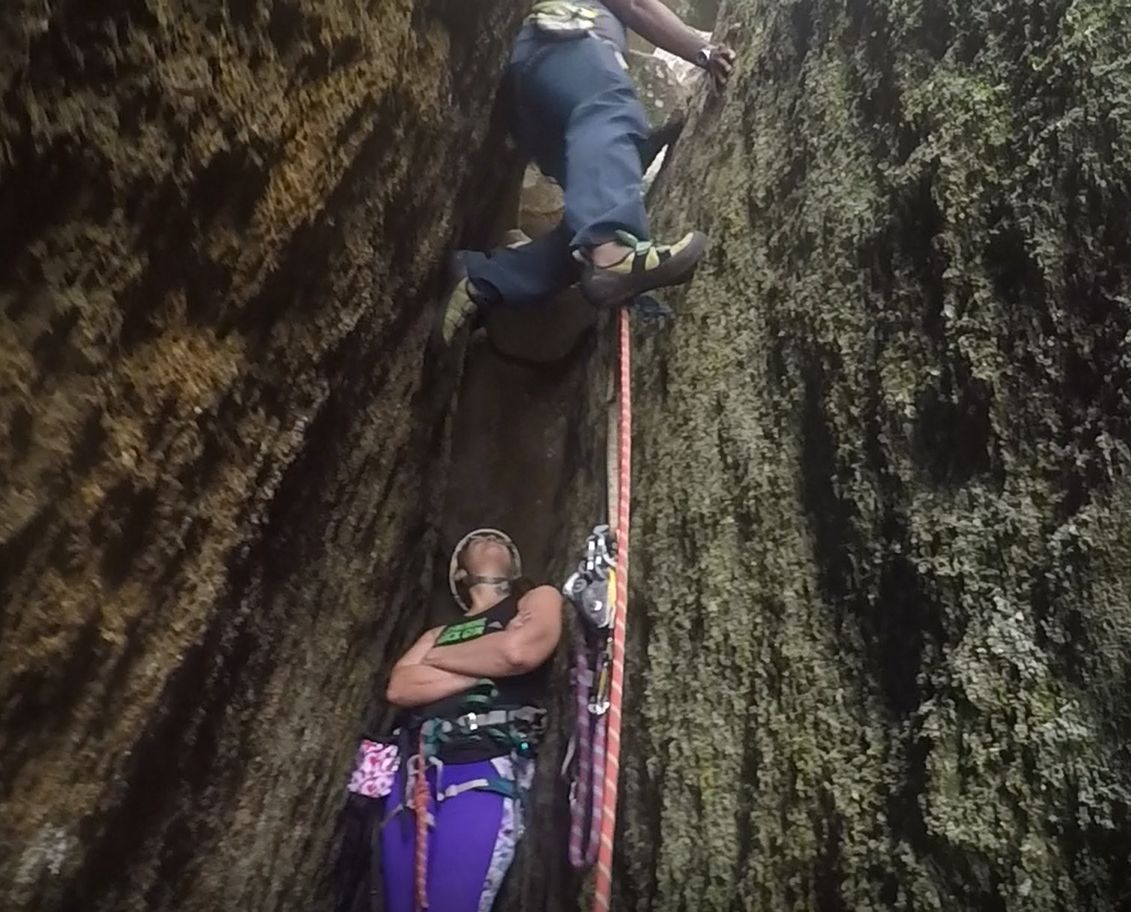
Marcia's red backpack hung beneath her on this part of the chimney. It was this subsequent slot that was really hard for me to get grip with shoes.
The next section had something similar – two vertical faces separated by about 30". Gilson and Marcia went up smoothly. Lucio showed me the places where he could put his feet on either side, then gradually make his way up. I tried the same spots and the same technique, but couldn’t get my shoes to stick to the walls. The toe that I sprained in the morning wasn’t helping anything either, as flexing that toe upwards to get more shoe surface on the rock was extremely painful. This was the one point where I thought about saying to the others to just continue without me. That lasted about half a second. Instead, I just did a rope climb on the rope hanging down to my harness. I used to be a lot better at rope climbs when I weighed 160 lbs, but I still got up. When I did get up, I hung my head more in shame than in fatigue, but both were factors.
We were nearing our last sections now. There was a stretch across to an open face rock, overlooking hundreds of miles of terrain below us. It was 1000 ft down to Teresopolis and another 2000 ft down to Rio.
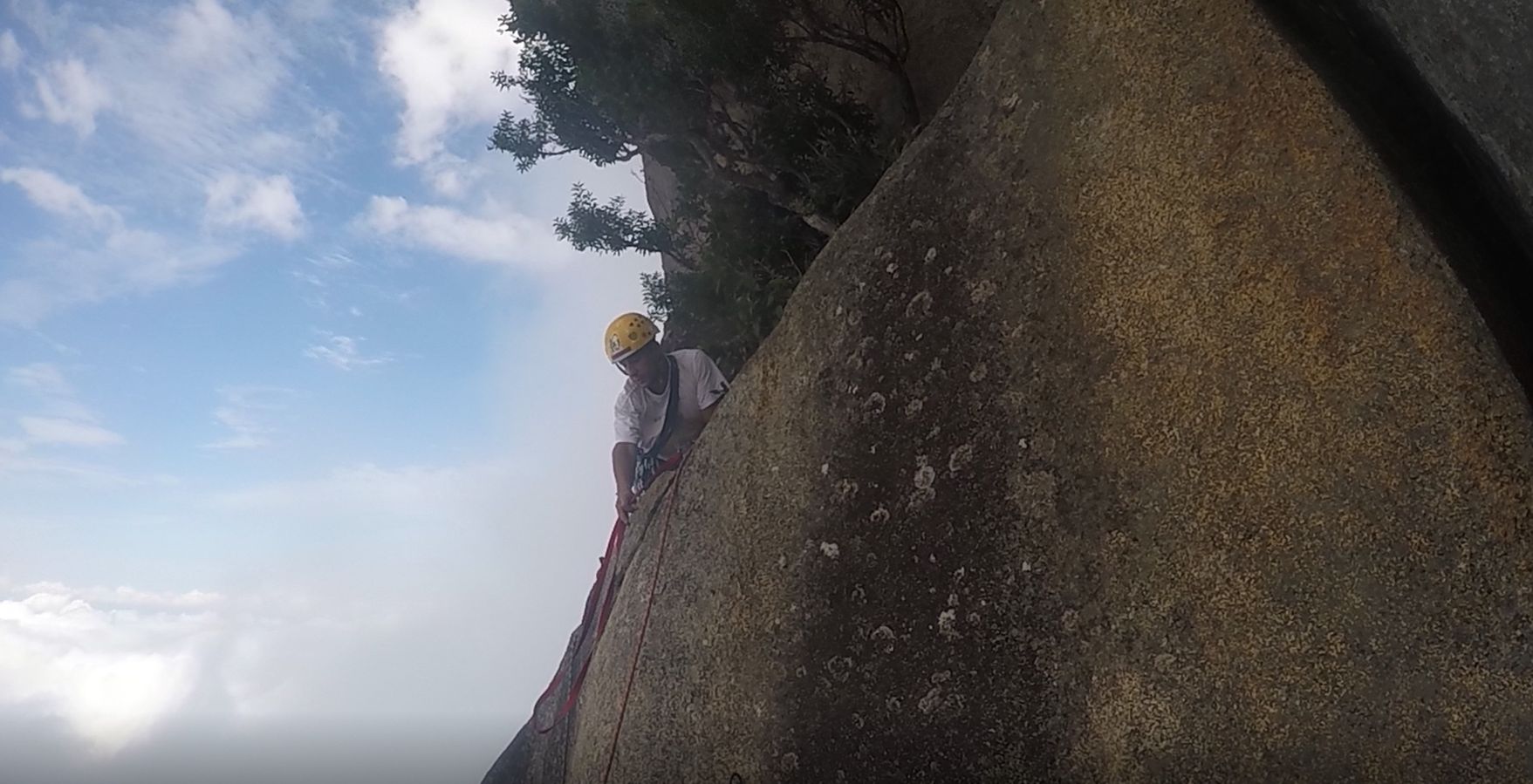
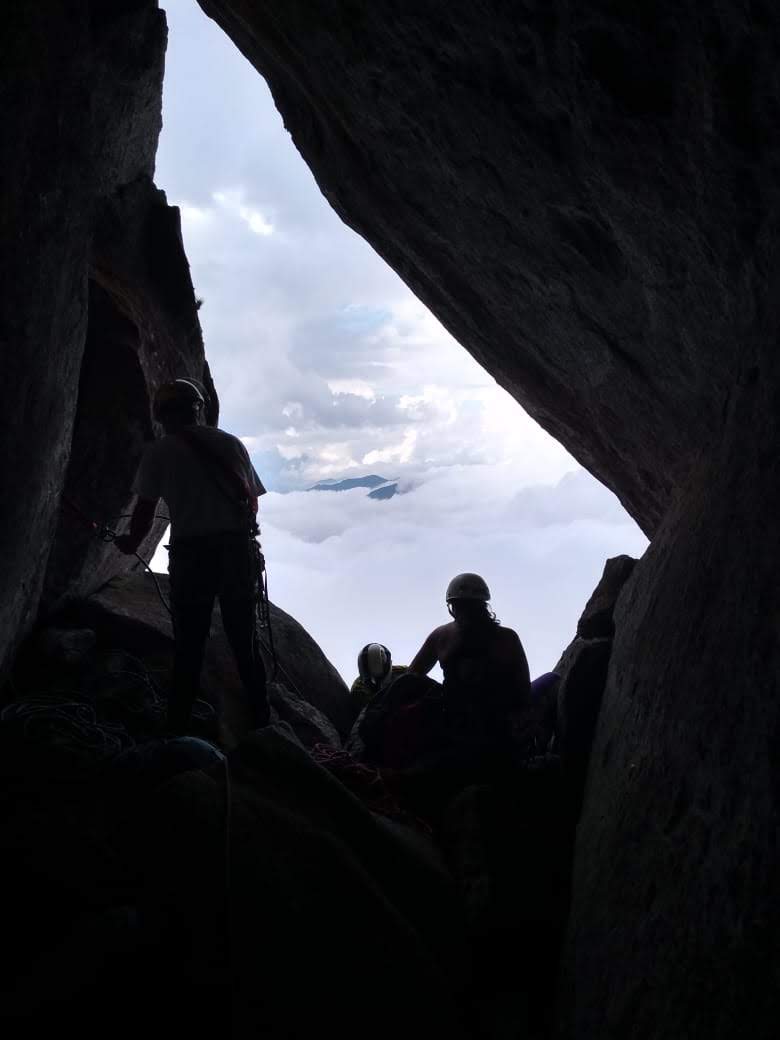
The sun came out briefly as we crossed a stretch with a huge view.
Then there was another section of using your back against one wall and your legs against the wall to go up. This one wasn’t as bad for me for whatever reason.
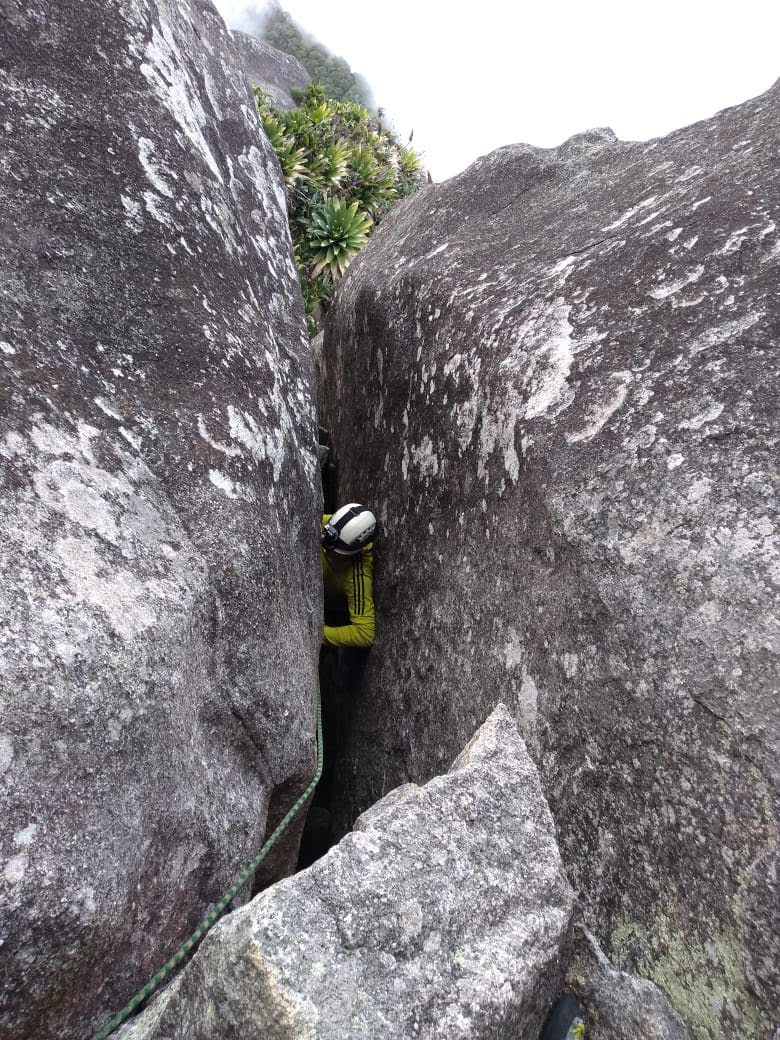
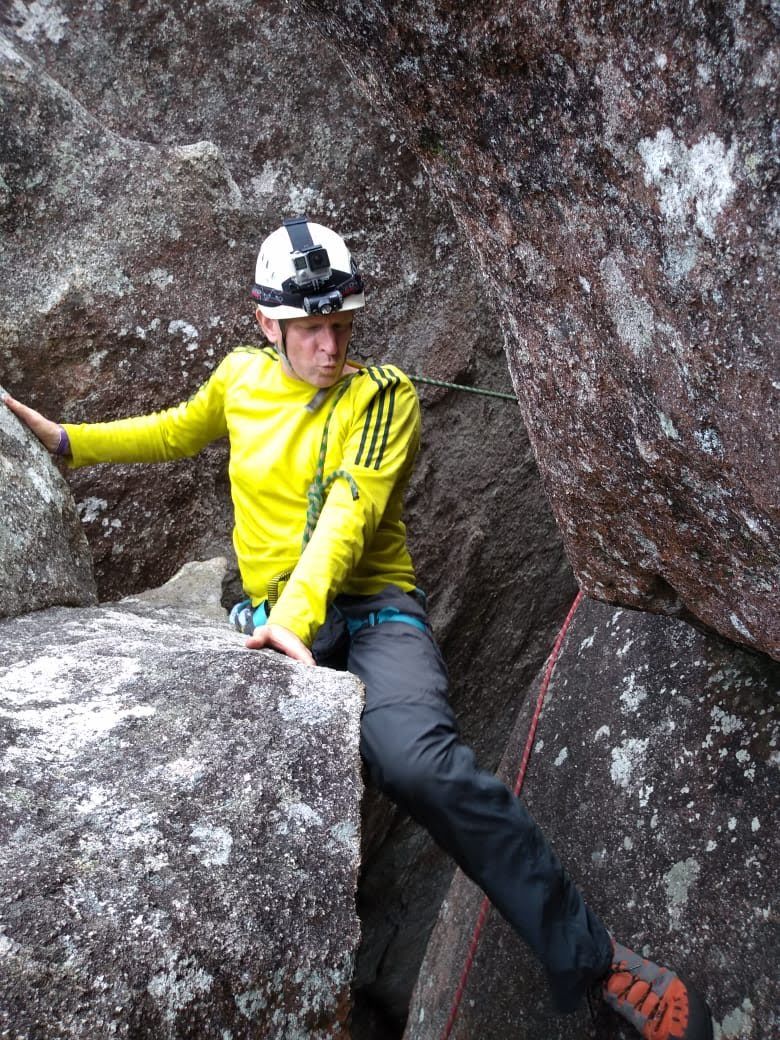
The last vertical segments
And then there was this near-final stretch across 30 degree terrain or so, crawling with fairly narrow vertical clearance. As with other segments, the backpacks were hauled up separately to allow us to climb without them making us wider.
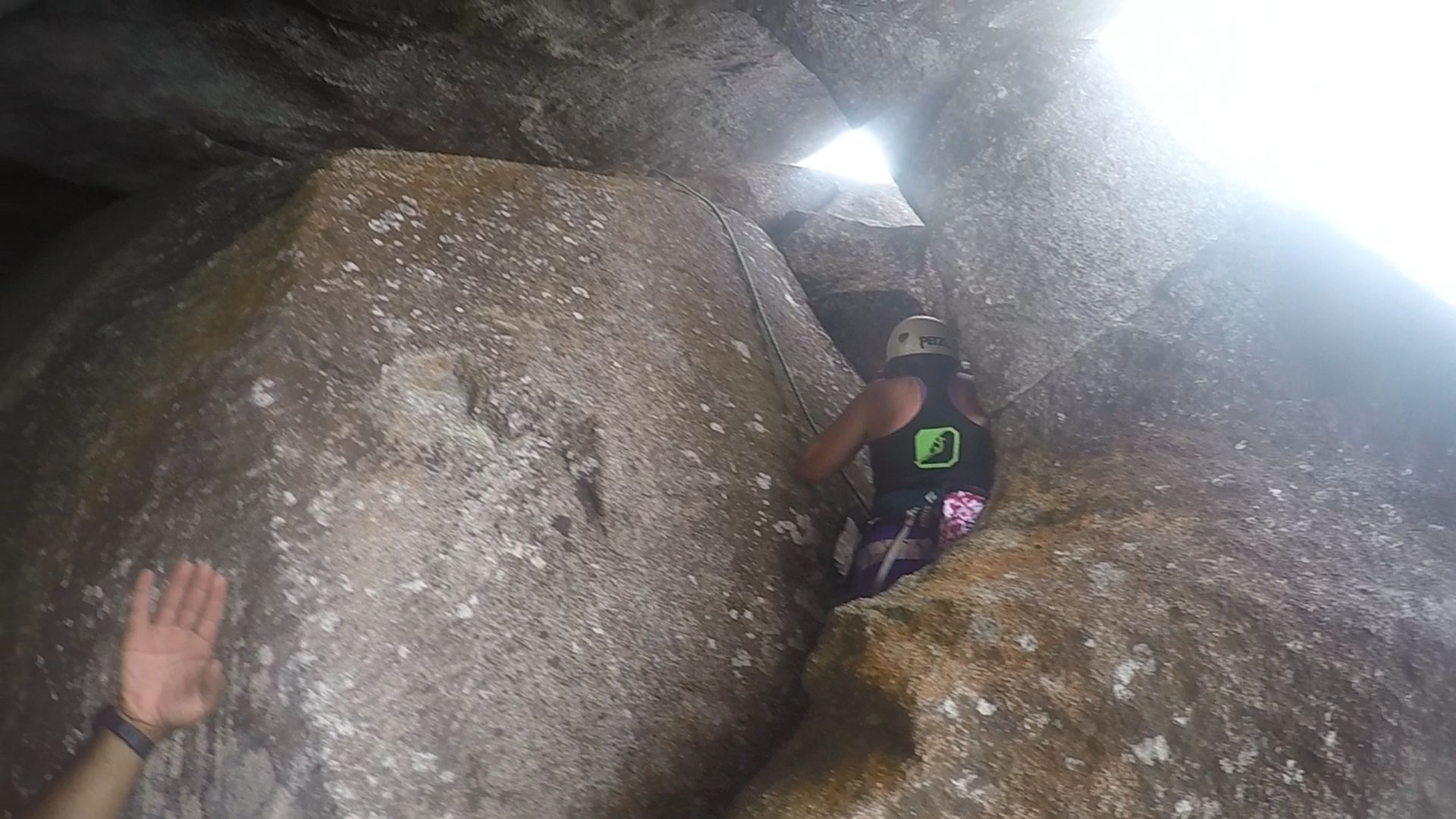
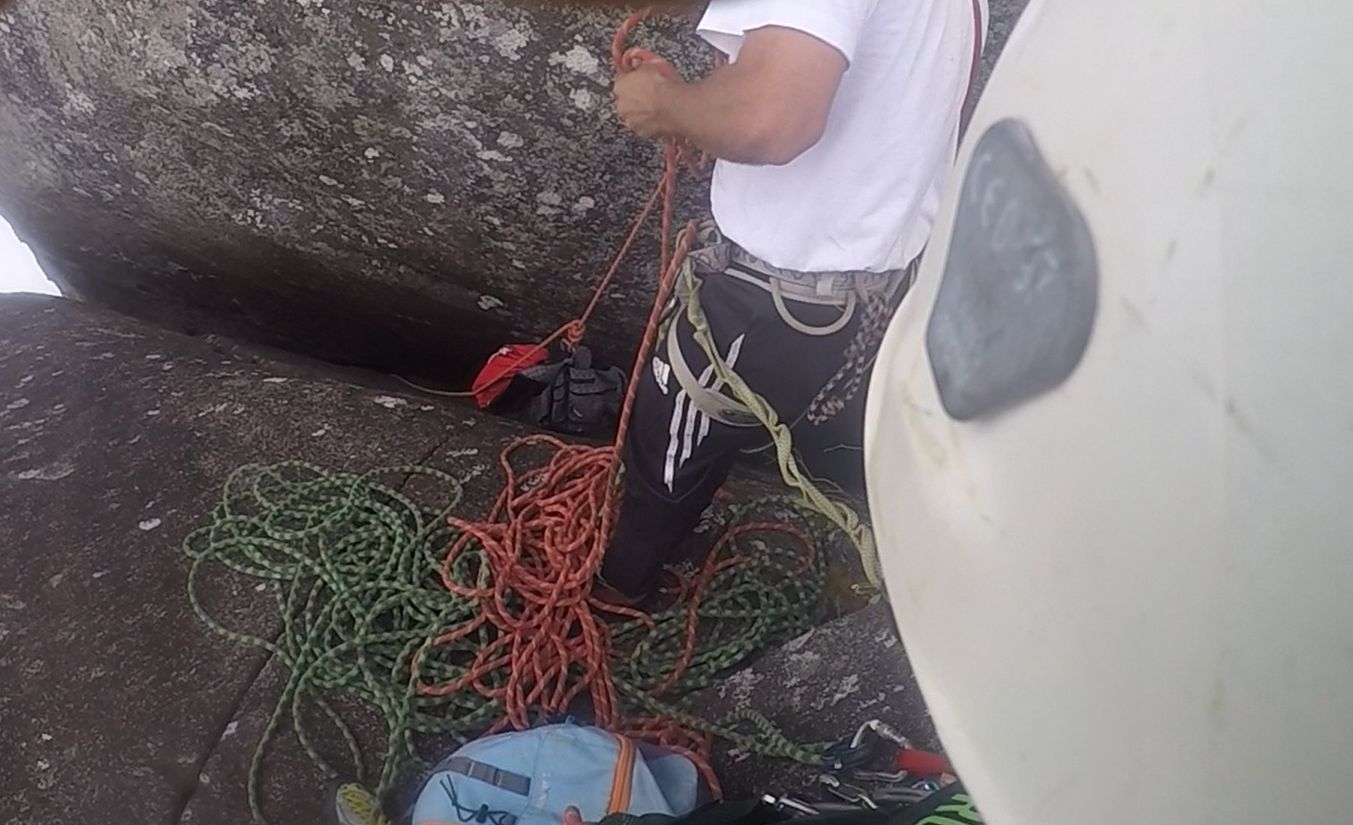
The last stretch with narrow clearance and the backpack haul.
At this point, we were standing in the fog, just a 5 m ladder climb from the very top of Dedo de Deus. I had been the last person going up every section up to this point. Now, oddly, when there would be no rope to secure me if I fell, I was the first. It was a ladder! How hard could it be? In the fog and on an aluminum ladder that flexed a lot, it still wasn’t hard, but it wasn’t exactly giving me confidence.
As I reached the top, I was super conservative, still using my hands when I know I would otherwise just stand up and walk. The heights, the fatigue, and the fact that I wasn’t tethered definitely were on my mind. Stay calm, cool, and collected. I finally got up and walked the last 50 ft, kissing the plaque at the top.
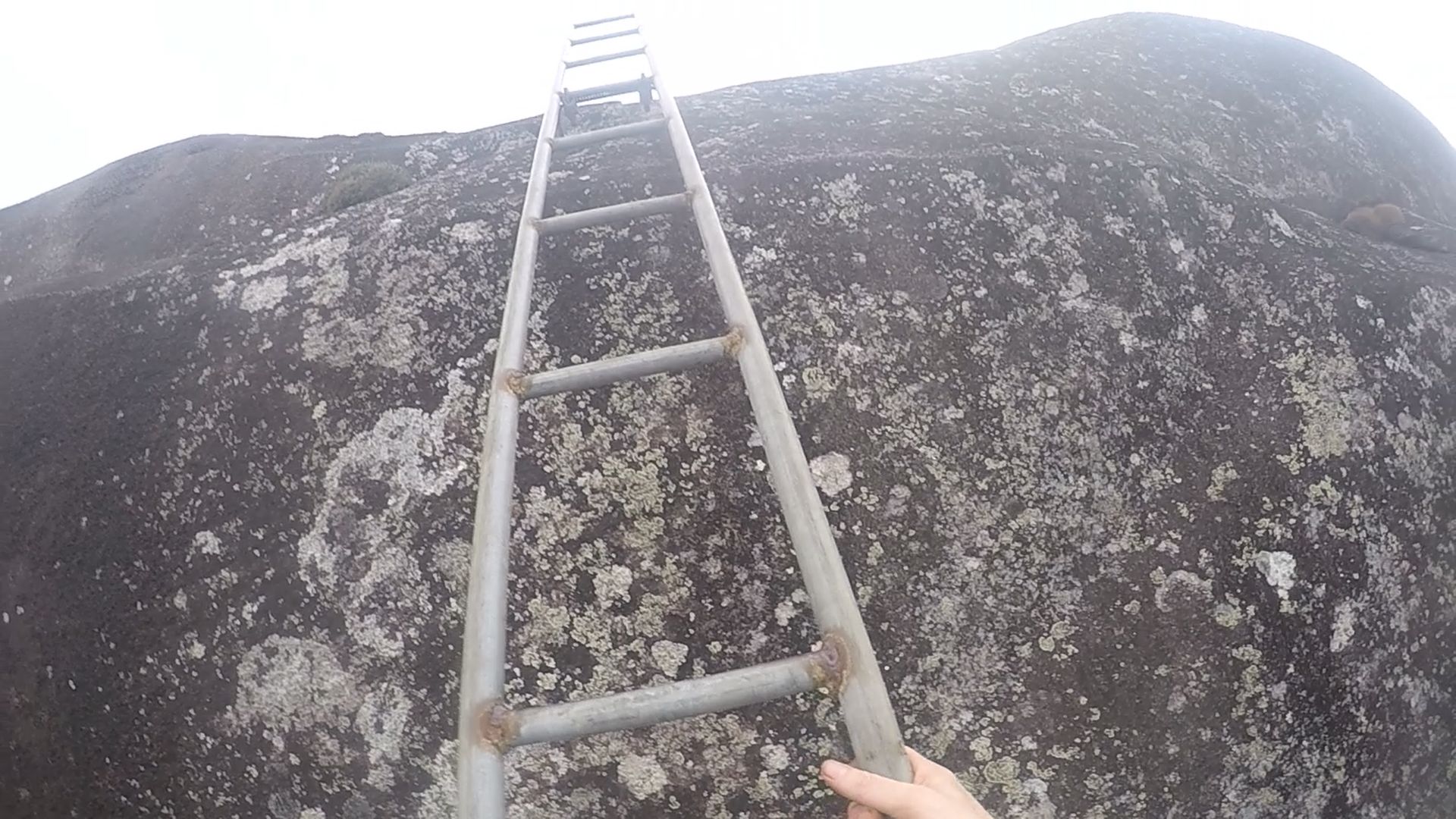
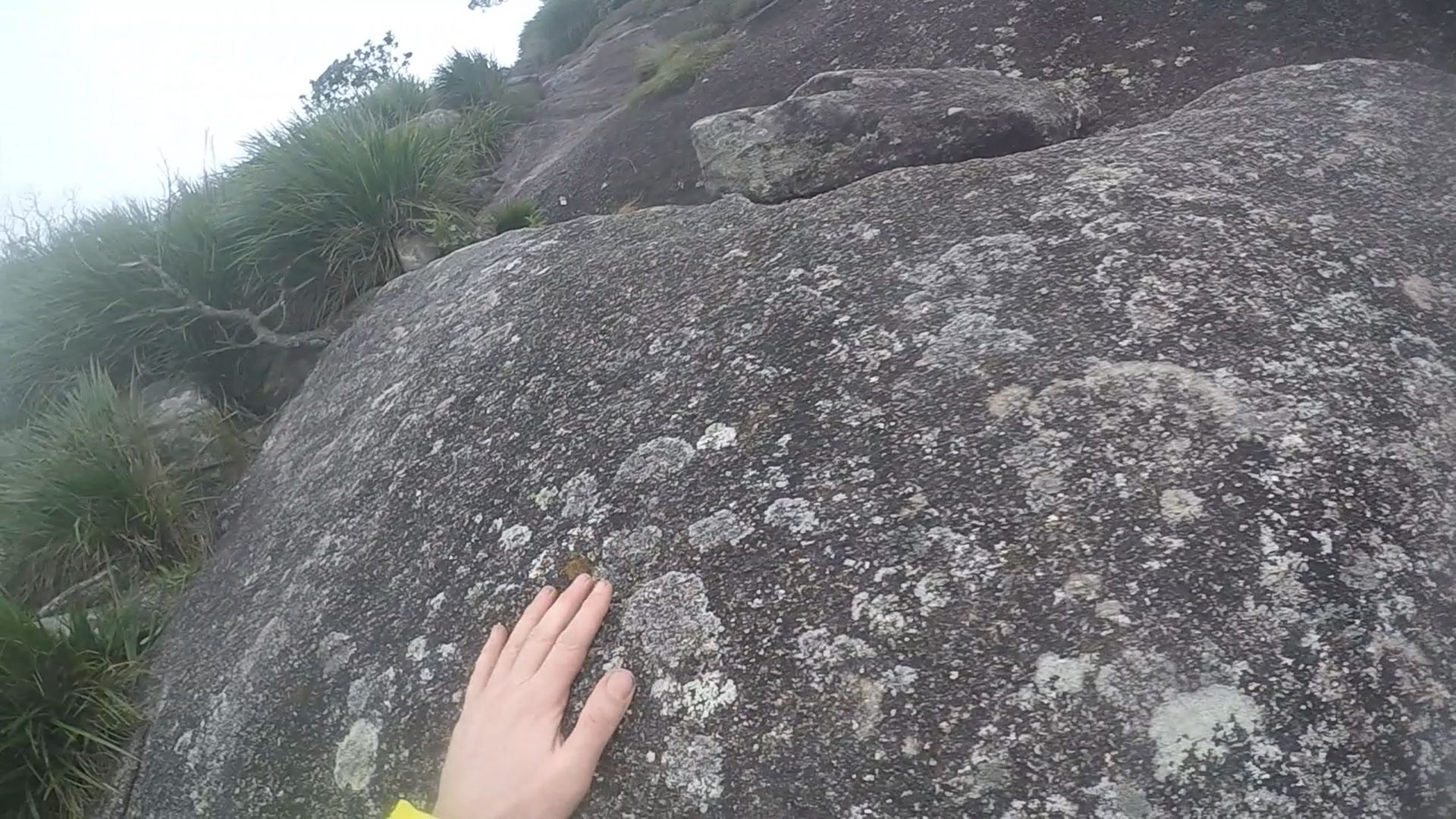
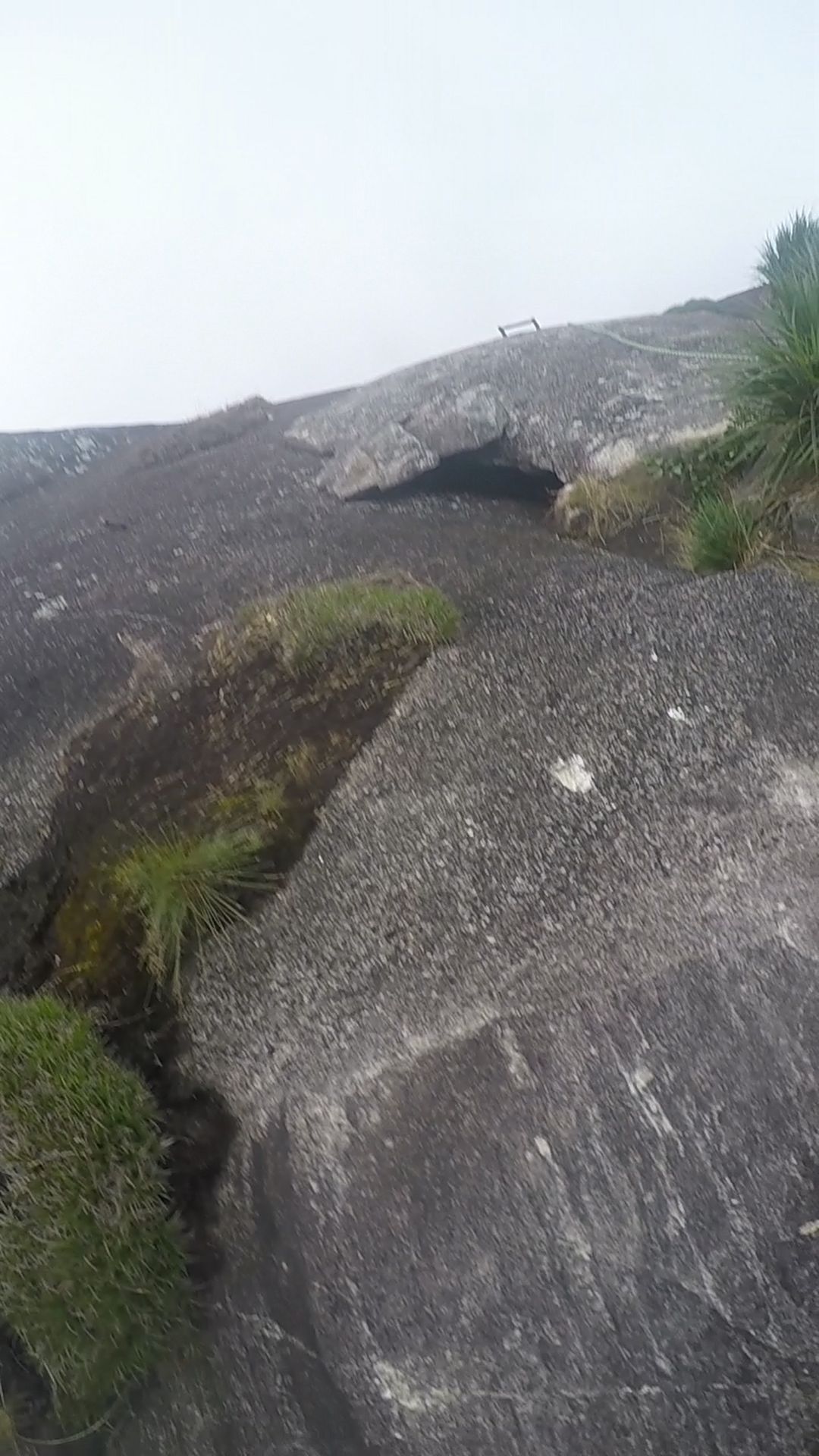
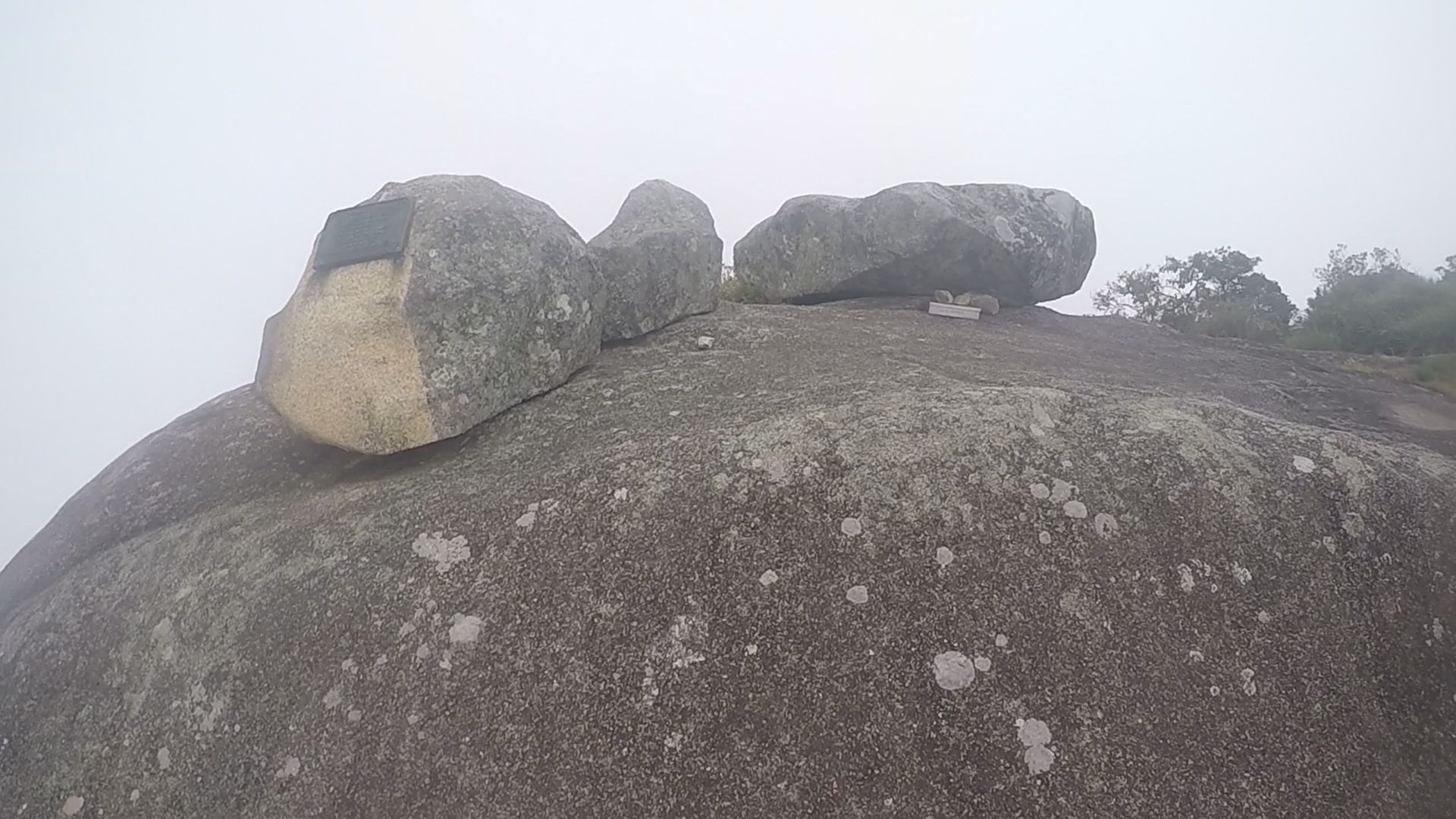
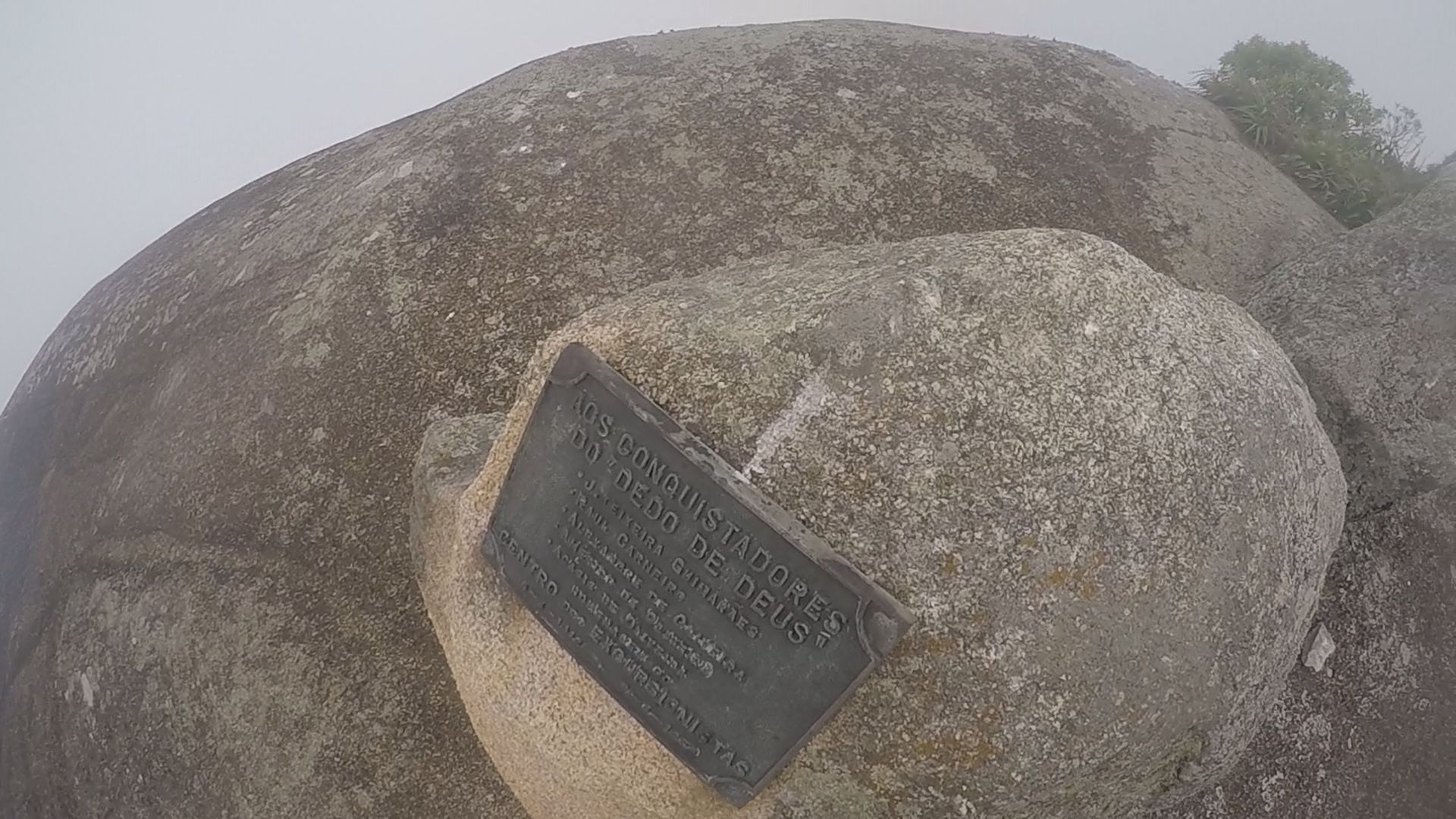
Getting to the top
I was alone at the top of this crazy rock, something I’d never seen nor heard of before meeting my wife in 2004. Even during that first visit to Teresopolis in 2005, it was cloudy for the first couple weeks I was here and I could never see Dedo de Deus. I saw the base, but I didn’t see the top until the last couple days. I had seen pictures and wood sculptures and t-shirts – Dedo de Deus is the symbol of this area. Being on top of it in the fog was a perspective that just didn’t match the symbolism. I couldn’t see its shape. I also couldn’t look down and see the places where I’d stood to look at it before. I could just as easily have been on the moon, I felt.
My wife followed me, maybe 30 s after I finished kissing the plaque. In my lame ability with a GoPro, I thought I recorded her coming up towards the top, but I had actually turned it off, so I missed it. But I remember the look on her face being the same tired look I knew I had. It wasn’t the pure ecstasy of arriving at the top. It was surviving. And wondering why they sent her up the ladder untethered as they did for me.
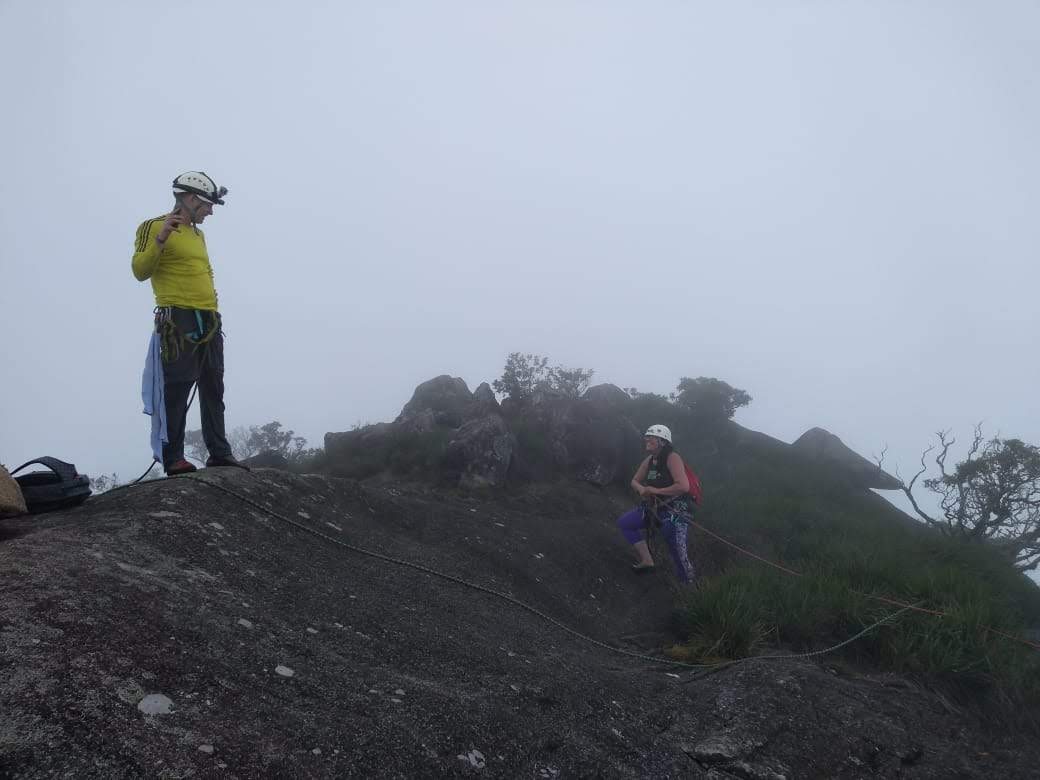
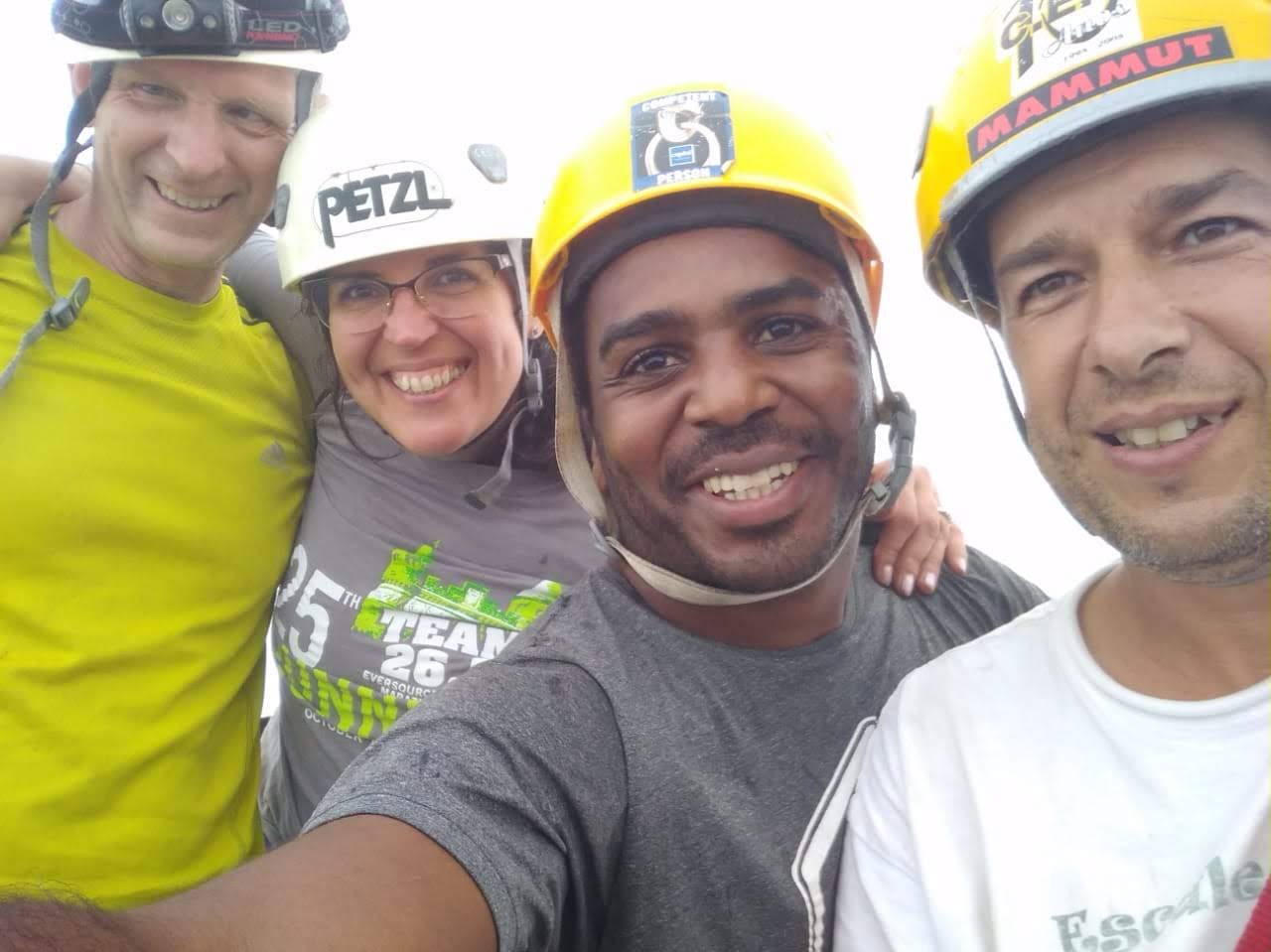
My wife going the last few feet. The four of us at the summit, taking a picture before we ate, signed the registry, and before the rain.
We embraced, kissed, and looked around at this small area that was the top. So unspectacular in its current appearance, yet so spectacular in all we had gone through arrive here. That journey will make every future view we have of this destination feel more special. (In fact, a few hours after writing this, we drove down out of Teresopolis and got our first view of Dedo de Deus since climbing it and we both looked at what we had done in awe.)
Gilson and Lucio arrived through the fog at the top another minute later. We smiled as we took some pictures. Even they, who have done this many times, enjoy the accomplishment. We ate the rest of the food we brought, noting how everything tastes delicious when you’ve worked that hard to get it. Then we opened up the registry to sign our names amidst the few hundred that summit that accomplish the climb every year. As Marcia was finishing her note in the registry and handing it to me, it started to rain. My hands shook with fatigue and I wrote fast to try to beat the rain.
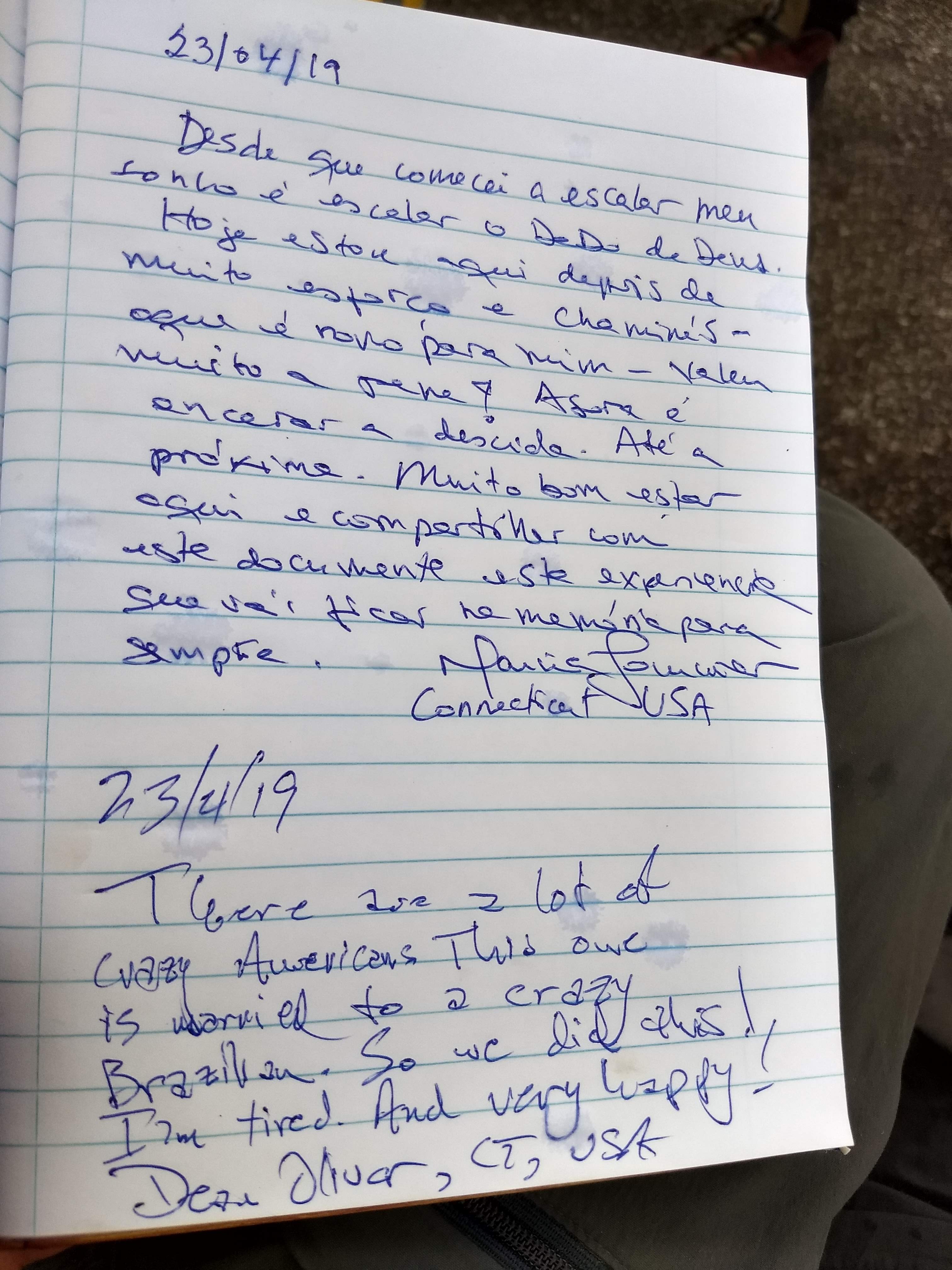
"Since I began to climb, my dream has been to climb Dedo de Deus. Today I finally got here with a lot of effort and despite the chimneys – which
are new for me – it was all worth it! Now we face the descent. Until next time. Very good to be here and share it in this document that I will keep
in my memory forever." – Marcia Fournier, Connecticut USA
"There are a lot of crazy Americans. This one is married to a crazy Brazilian. So we did this! I’m tired. And very happy!" – Dean Oliver, CT, USA
The rain fell in huge cold drops. In the two minutes it took to get over to the ladder and for Lucio to descend it, we were soaked. Despite not being tied in on the climb up the ladder, they tied us in for a rappel down the ladder. The rain was raising the risk level.
The large granite top where the ladder was anchored at the bottom was probably 15-20 ft across to a real edge. Gilson still told us to sit down and skooch on our butts to move toward the edge from which we had done our last chimney climb. I was thinking about how slippery the wet rock was at the start of our cable climbs. The short rappel at the edge here was down through a crack at about 20 degrees, a weird sliding action with very little head room. We were getting cold, we could sense a little bit of concern, and this section was very tight. There were a lot of reasons to not feel comfortable as we looked down at our first real rappel.
Lucio set it up, the red rope dangling off the small area the four of us were all tied into. The rope went down about 60 ft, then there was a horizontal gap of about 10 ft where the rope went over another edge that we couldn’t see over. Marcia saw Lucio work his way down the soaking rope with giant rain drops forming the background. The sound of waterfalls forming dynamically on the nearby mountains was a growing roar.
Marcia and I followed in the rappel, the rain lightening up a little for us. Going down backwards and moderating the speed, the rappel is something that we have done before, but Marcia hadn’t gotten very comfortable with. Being exposed to a 1000 ft drop in the cold rain was adding a bit of extra nervousness. She was telling herself to ignore the fear because it wouldn’t help. That seemed to work because she got comfortable pretty quickly.
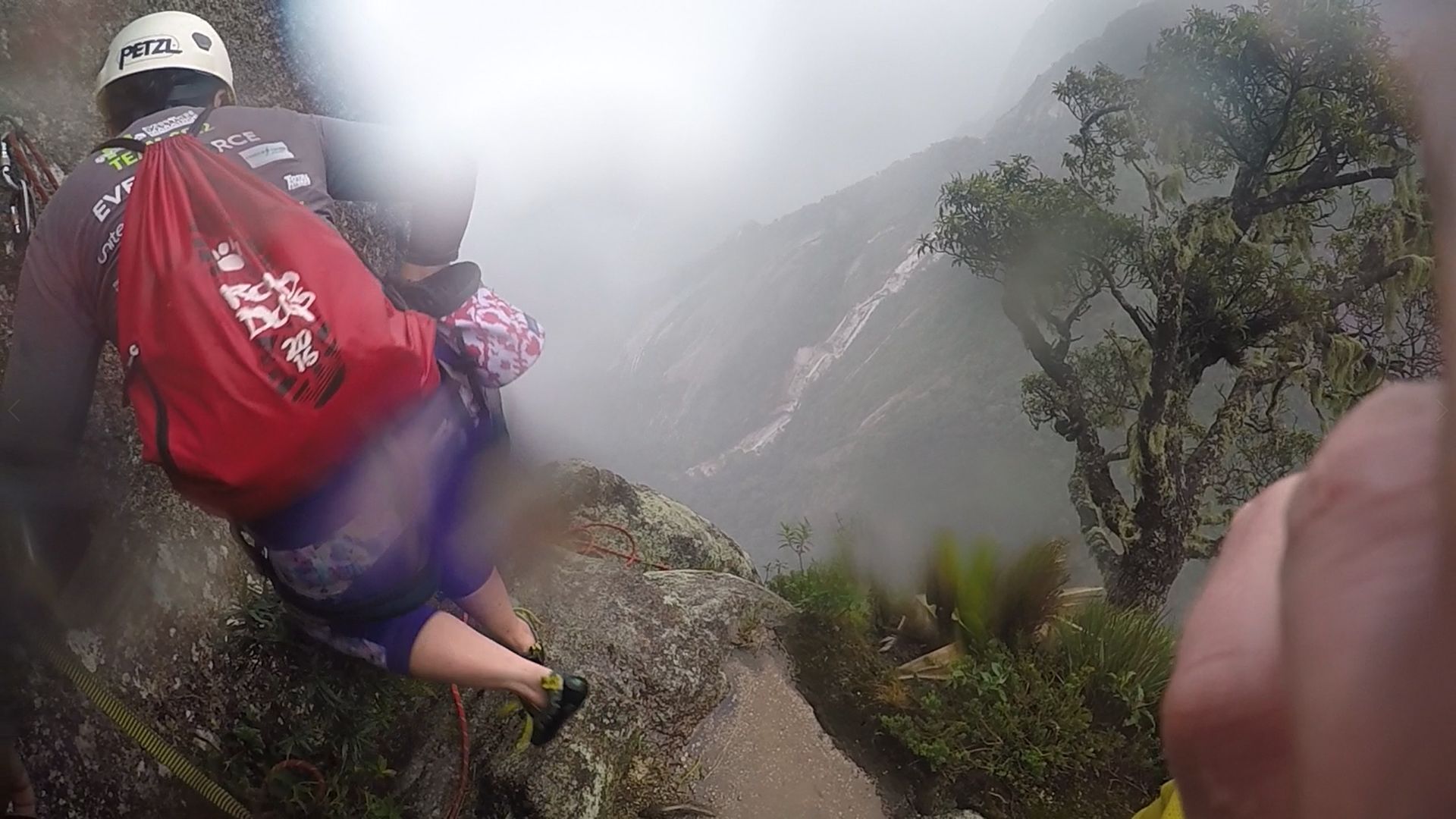
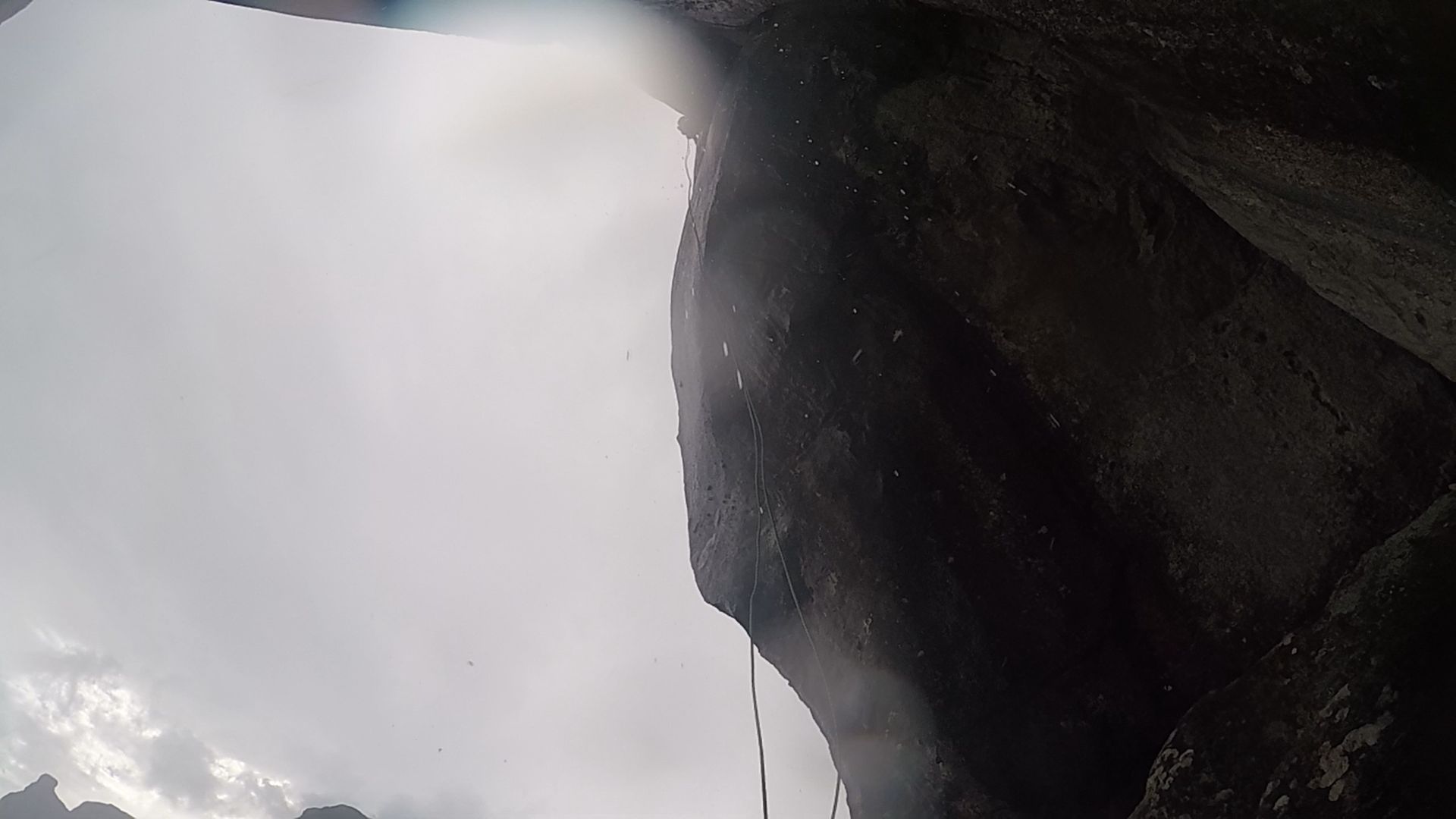
Some of the rappels. The second one shows waterfalls being formed in the background.
There were several other rappels on the way down, one of which was basically a drop with no mountain to put your feet on. We just lowered ourselves down 80 ft of open air – like a spider – as the sun started to peek through the clouds, making for a beautiful view.
The "last" rappel was not the last, it turned out. The trails were wet and slippery, so some areas that may have just been hikes or holding onto the cables became rappels. That ascent up the cables hours earlier became a crazy multipitch rappel down, especially when the thunder and lightning began. From 4 pm until we got out at around 7:30, it was nothing but rain. And darkness. Everything was drenched and dirty. The rope, our clothes, our shoes, our backpacks – they were going through mud and constant rain. But at least it wasn’t as cold as it was at the top.
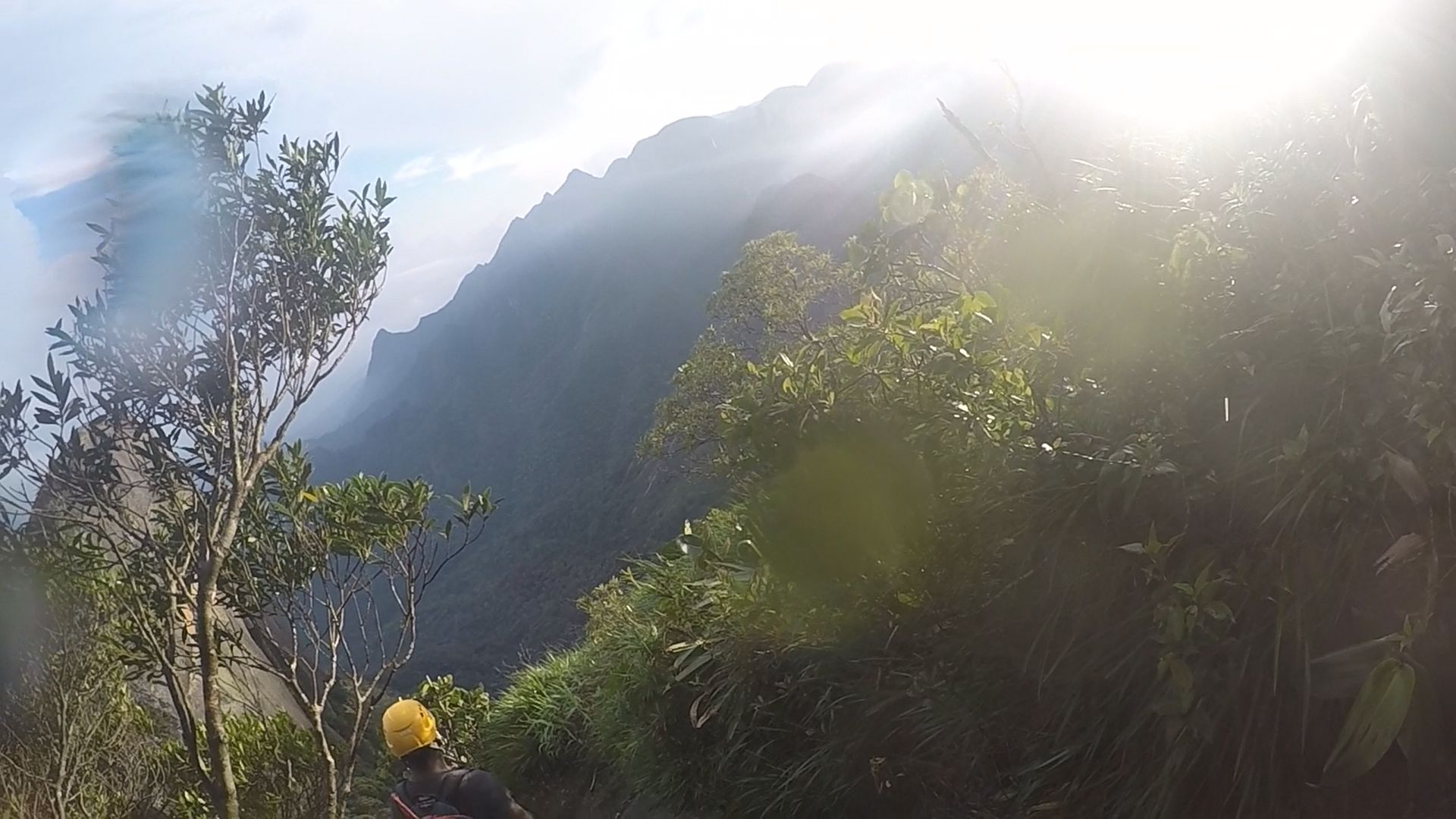
Sunshine between the rains.
The rappels down were effectively rappels through waterfalls as the rain coming down was so hard as to form waterfalls, with pools 6" deep. It was pretty hard to see much of the falls as darkness was upon us and our headlamps were mostly focused on seeing where we were going. When the rope got dirty, it made the rappel extremely hard as you couldn’t just let the rope go through the belay device and slide down at a controlled pace. The rope would stick and you’d just stop, then push up with your legs to take the pressure off, so that you could go down a few extra feet. The way down wasn’t supposed to be so tiring.
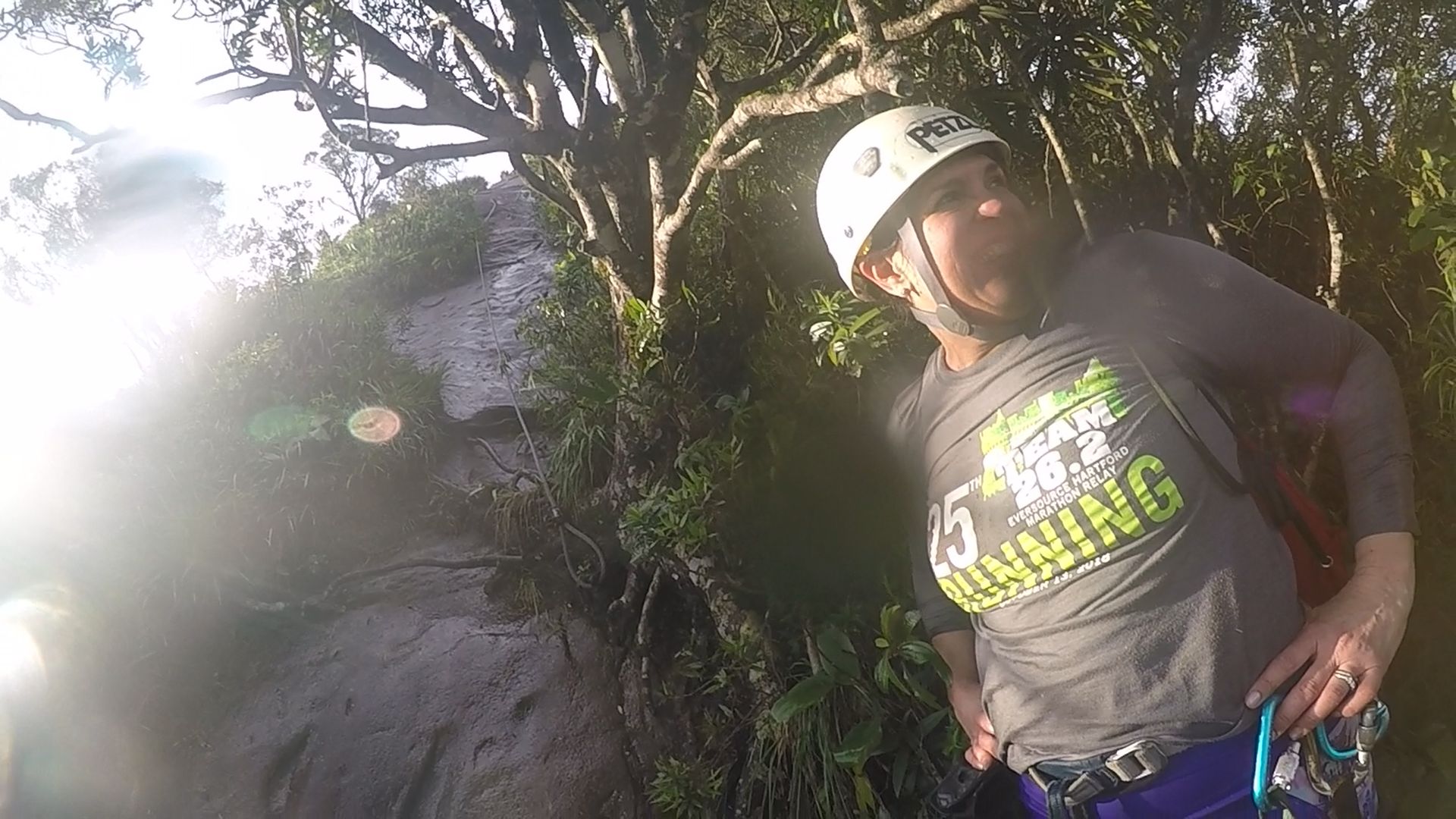
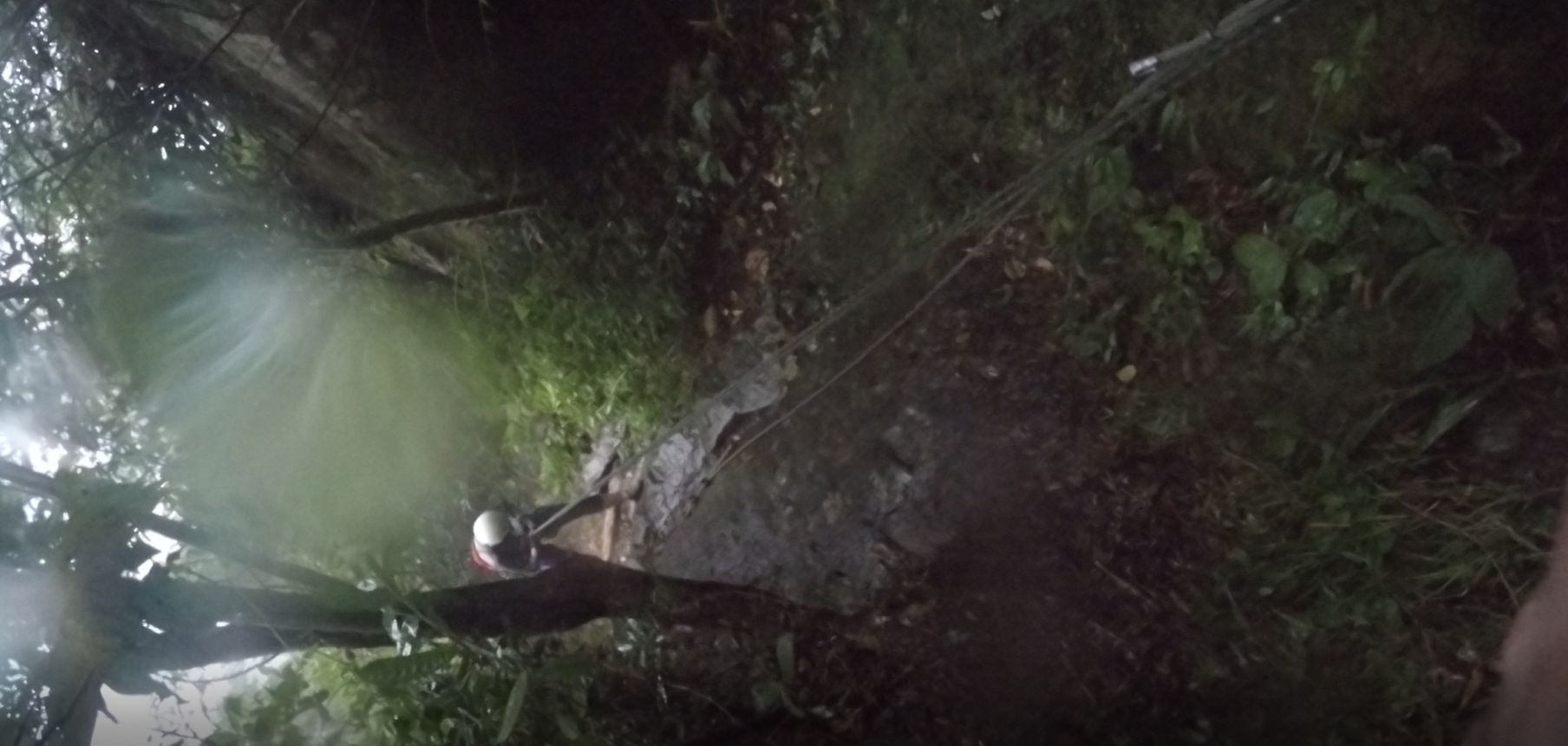
These were more mellow rappels, down more gradual rock and mud, with the rain forming effective waterfalls at times.
Between the hiking, the climbing, the rappelling, and the shivering, I felt like either my arms or my feet or my abs would cramp up. On the second to last rappel – a 200 ft version in driving rain on a section of granite that had a hundred foot fall off the edge – my sprained toe and sore feet were desperately wanting to stop working. At the edge of our final 140 ft rappel, I stood while Marcia went down. I could see her headlamp through the rain as she got farther away. I was desperately waiting for the random almost inaudible sound that indicated that she was all the way down and that the rope was free for me to descend. Finally, I heard some human voice say something, probably "Liberado", meaning that the rope was free.
I tried to go pretty fast. At this point, I didn’t really even notice the rain because we’d been in it so long. The rappel was easy except for that anticipation of taking my $%@#% shoes off. Upon freeing myself from the wet rope, I went over towards Marcia, who was sitting in the relative dryness of a partial cave, and kissed her. Then I took off my climbing shoes and wanted to kiss my regular hiking shoes.
At the base, we spent the next 10-15 minutes cleaning up the climbing gear, changing into hiking shoes, and eating a little bit of chocolate that Gilson brought.
We were giddy in the notion that we were almost done. People were talking back and forth as Gilson led the way down the remaining hike, Marcia behind him about 30 ft, me behind her about the same distance, and Lucio behind me. And then, after about 15 minutes, we all got quiet. It was still raining, it was still dark, the trail seemed entirely unfamiliar and steep, and we were tired. Step by step through puddles, over roots, with bamboo slapping you on the head, with bugs chasing you for light in the headlamp. We ate a few bugs, I'm sure. We had to sit down for some slick rocks, but mostly it was grasping every surrounding tree or vine as you took another large step down. For the next 45 minutes. I don’t think we said anything else until we were within a minute of the roadway. The sound of traffic never sounded so good.
A day after we exited the trail, we’re still drying out our shoes, our muscles are still recovering, our bruises are visibly showing up, and my sprained toe is hurting more than when the adrenaline of yesterday was coursing through my system.
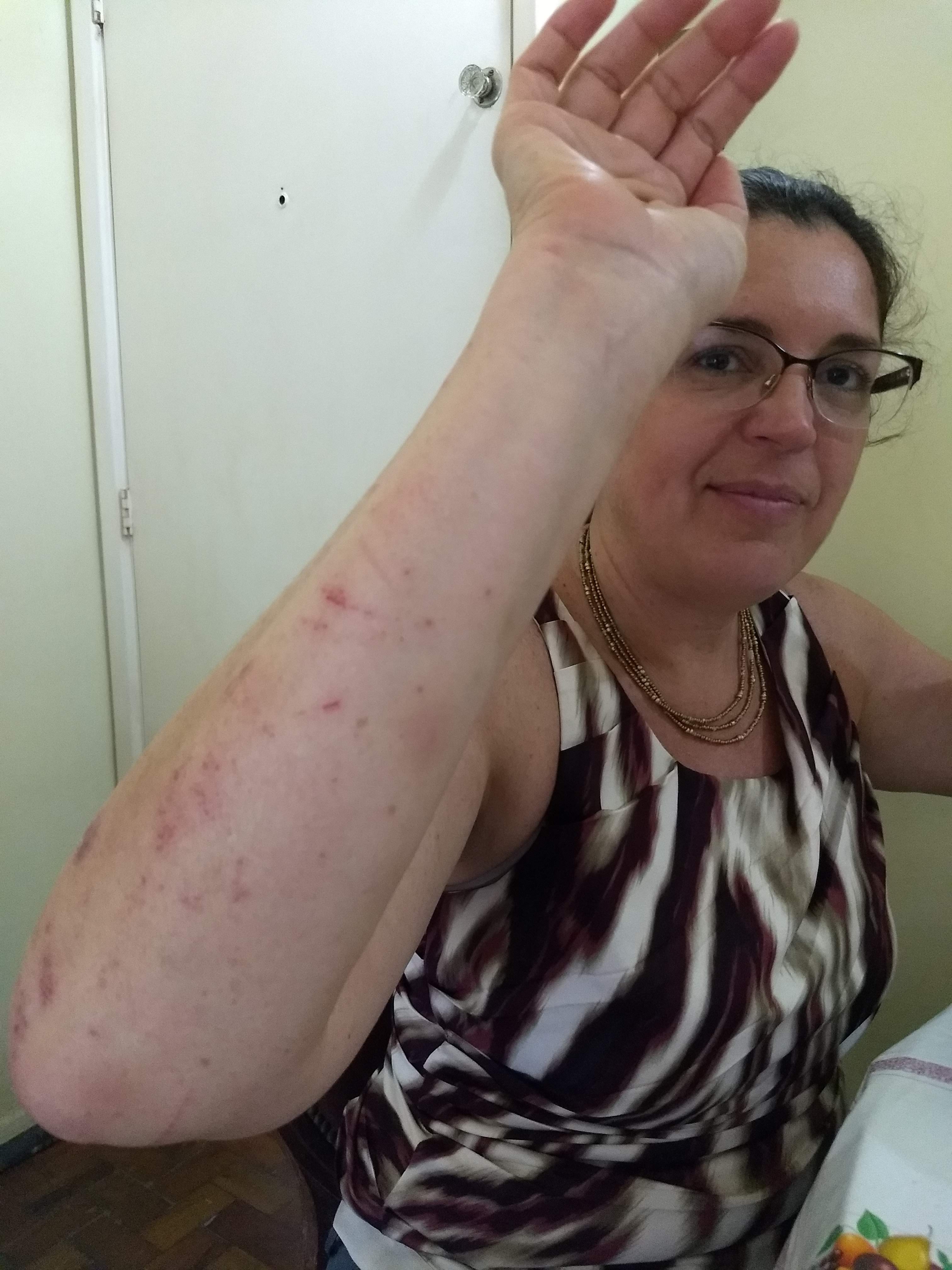
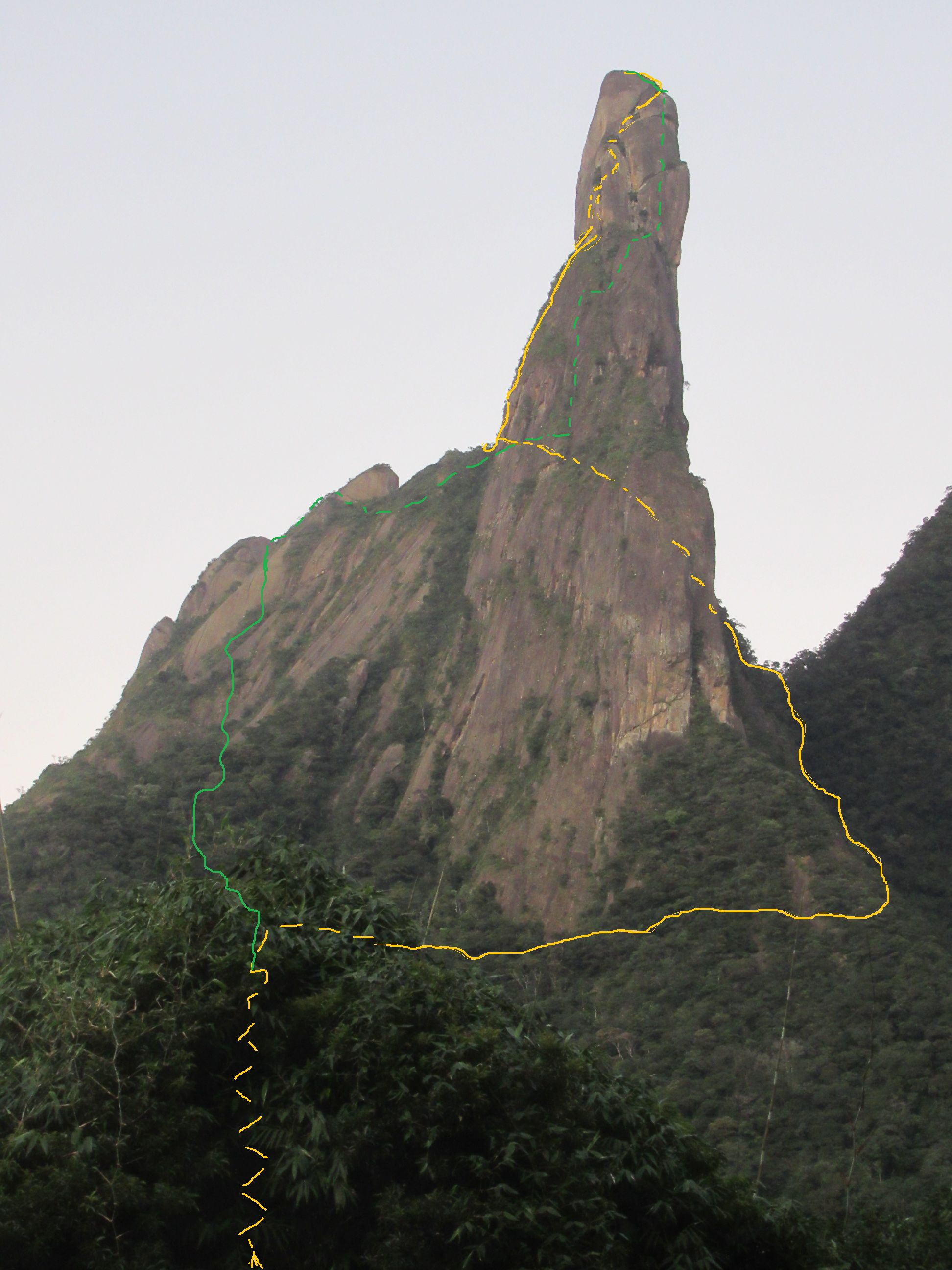
On the left are some of the bruises and scabs on Marcia's arms as a result of the hike. We also had them on our legs.
On the right is our best guess of the routes we took to go up (yellow) and down (green). The dashed lines indicate when the route is actually obscured
in the photo, hidden behind the rock itself or behind the tree foliage.
Marcia did tell me that this was crazier than she wanted it to be. She told me to talk her out of it if she comes up with something else like this. I’m not sure what that something else could be and I’m definitely not sure that I’m the right person to be recognizing what is crazy or not.